The slot referring to my song starts 27:20 – 34:06
-
-
TIWOM – The Insignificant Whispering Of Men

Finally out 🙂 I’m super happy with the result of „The Insignificant Whispering Of Men“.
The creation of this song about hate, violence, greed and the dark side of humanity, took over six months of dedicated work. Multiple cycles of composing, improvising, recording, discarding and starting over resulted in what I present here: Powerful guitar lines, Anup Sastry’s virtuoso drumming, Toby Peterson-Stewart’s complex bass sounds and Jacob Lauing’s extremely expressive voice form a metal-esque soundscape that combines classic and modern progressive rock styles. As a guitarist and producer, I tried to follow my own vision of cross-genre rock music.
I developed a close relationship with this piece, which I lovingly tried to transform into detailed sound images. “TIWOM” is my most recent and most complex production to date.
Special thanks again to:
@anupsastry
@tobypeterson
@jlauing
Marco Quast
artcore_nftUnlock the full video experience on YouTube! 🌟 Join the community by subscribing, following, and giving a thumbs-up. Your support fuels my journey! https://linktr.ee/markevertz
© 2023 MARK EVERTZ MUSIC
-
NO TUNES

After ~ 34 liters rosé, 28 sausages, 9kg cheese, 23 baguettes and +- 450h of work, I finally release my first EP “NO TUNES”.
The project started in started in 2020 with the first few sketches. From June-(mid)August’21 I stayed for two month in an beautiful environment of south France (an area close to the village Pied-de-Borne),
to (re-)track, produce, mix and release 6 tunes plus two bonus tracks: “No Tunes #22 (Assertion & Reason)” contain some sound design experiments borrowed from I&EDM genres,
while I break new ground with “No Tunes #18 (Time)” — the first time that my attempts at singing don’t end at the bathroom door.My focus on dealing with mixing techniques, workflows and tools in the summer months has given me an amazing experience. Such many insights have made the respect for this discipline grow again and tempt me to start all over again. But at some point you have to let go — next time everything will be better :-).
No Tunes #1
I recently created a passion for prog rock music. This is the first release of my “No tunes” project. A journey to learn, write and mix music of that genre with its heavy and powerful vibes.
No Tunes #14 (Spanish Lie)
I have no idea how No Tunes # 14 got that pseudo-Spanish touch. I was looking for something that contrasts the mid tempo rock / funk groove that makes up the main vibe of this piece without introducing a lot of new elements. The descending bass line you hear at 12:10 a.m. inspired me to do a more fusion-like solo ~ 2:00 a.m.
When mixing, I followed a recommendation to use reference songs a little differently. I made a track that has about 16 snippets of different matching songs from different bands, each about 20 seconds long. Jumping around in these references should avoid clinging too much to the frequency spectrum of just one track. It’s not quite what I want to sound like yet, but it’s moving forward. By the way: The visual comparison of the waveforms of these snippets is quite interesting. You can clearly see how very differently dynamics are dealt with. It looks like recent recordings in this genre are less brutally compressed. Although according to the loudness meter (compared to LUFS) the songs are actually on the same level. Plini songs, for example, are much more dynamic than comparable songs. I wonder if this is a side benefit of the modern streaming world?
No Tunes #26 (Gravity)
Heavy, intense and fast. I tried to create a lot of excitement in a shot period of time.
No Tunes #8 (Spare Shadows)
Prerelease of my latest one. A bit less proggy, but a more atmospheric vibe. Still challenging to me to guide the listener better with more automation i.e. track volume. While I feel to actually progress with my mixing skills, all in all the whole process is very time consuming and a lot of work. I am thinking to pay someone in the future for that.
No Tunes #2 (Moving)
“No Tunes” develops a simple motif that I tried to move through different chords until 02:25. After that I actually forget everything, rack’n’roll riffing until the end 🙂
No Tunes #24 (Cheesy Weather)
While I enjoy the summer evening hours in a mountainous area in the south of France, I got inspired for a more easy-going kind of rock tune. The piece is walking around a simple, cleaner guitar riff in E Minor (Dorian), followed by a pre-chorus and chorus using different diatonic chords in the key D Major. Melodic parts are dominated by a “Strat-like” lead guitar sound mainly using the E Minor pentatonic.
No Tunes #22 (Assertion & Reason)
Playing around with some stutter, glitch and other effects I enjoy while listening to E&IDM music, I came up with this vibe. It didn’t developed into a full song. Hence, I decided to add it as a short bonus.
No Tunes #18 (Time)
I fooled around with my voice and recorded myself singing for the first time.
Originally I didn’t planned to add the track to the No Tunes project, but after introducing it to friends & family, I felt encouraged to add it as the 2nd bonus track. I hope you like it.It’s the time we know
It’s the time we grow
The time is passing by
We flyThe words we say
The games we play
Reasons to stay
Time is passing byThe life we live
To give and forgive
The time is passing by
bye byeIt’s the time we know
It’s the time we grow
The time is passing by
We fly
-
DIY Basstraps
Simple self-made corner absorbers.
Deutsche Version: https://mark-evertz.medium.com/diy-eckabsorber-bassfallen-bb85c7aa04c
Hopefully word has got around that egg cardboard cannot really acoustically nurture rooms. In particular, low frequencies tend to collect like dust flakes in the corners of the room and pile up to unpleasant wave crests (Room modes https://en.wikipedia.org/wiki/Room_modes).
As the last phase of my DIY project to build a soundproof booth (https://mark-evertz.medium.com/diy-acoustic-booth-english-version-bd6e91614318), room acoustics was a concern. I wanted to get a grip on those room modes that falsify the hearing impression and are therefore annoying (also known as standing waves) using corner absorbers (bass traps or bass straps).
My approach was less scientific than pragmatic. I saved acoustically measurements and calculations for the size, volume and material of optimal absorbers and only used residual materials from my studio construction project. I will check with a later acoustic measurement whether my take-what-is or better-than-nothing approach is successful.
The following article is recommended for those who deal with the topic in more detail:
https://www.bonedo.de/artikel/einzelansicht/raumakustik-workshop-no1-eckabsorber/2.html
Construction
The basic construction consists of a 1cm square plywood board, which I sawed into two isosceles right triangles (25x25cm). 1cm thick square timbers are glued and screwed onto this (don’t forget to pre-drill). Halved squared timber (triangular base area), which you can get cut to size in the hardware store, fit into the acute angles.
Since my absorbers max. 75cm high, I didn’t need any cross braces for stiffening. I think it starts to get shaky from around 100cm.
Since the shape of the squared timber cannot be clearly seen in the photos, I made a small sketch with SketchUp (https://www.sketchup.com/).
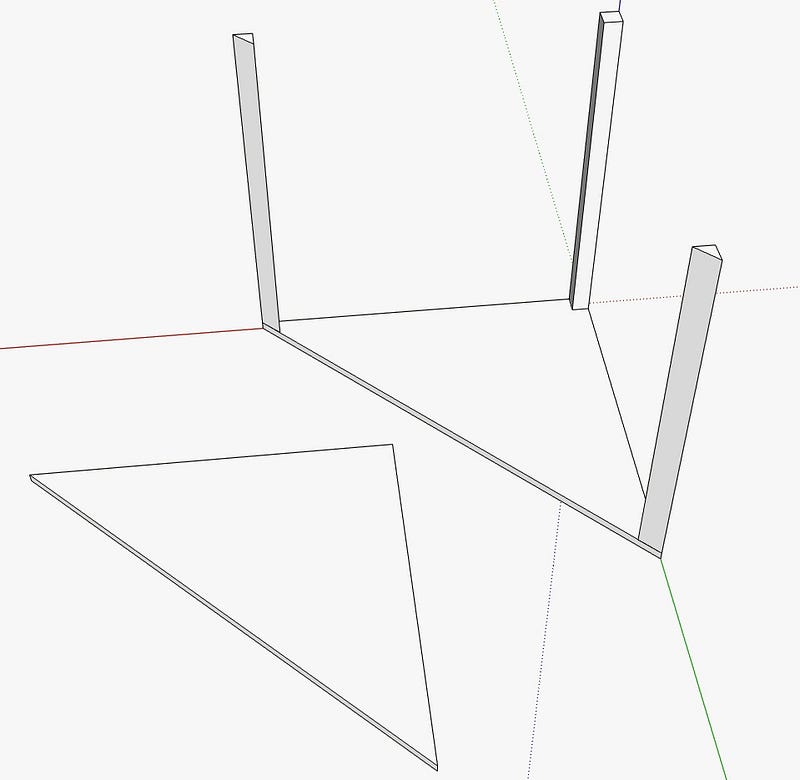

Scetch (SketchUp) of base elements Shell
I covered the absorbers with thicker cotton fabric (Molton: weight: approx. 160 g /m), which I ordered by the meter here https://basteln-ch.buttinette.com/shop/a/baumwoll-flanell-schwarz-57929.
The fabric isn’t cut very precisely and stapled to the frame under tension. To make it a bit pretty, I only stapled the fabric on the short, back sides. No brackets can then be seen in front.
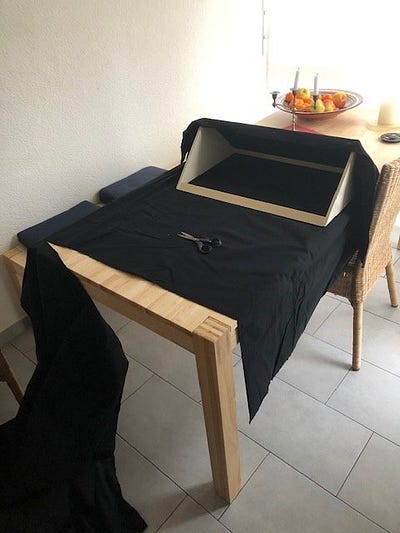

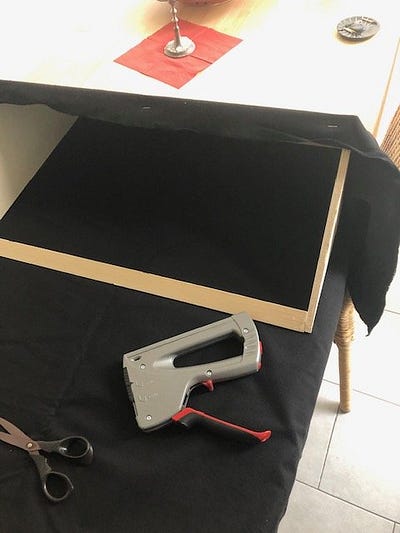
Molton (cotton) by the meter Filling
I used leftover mineral wool for the filling. Compared to other materials, mineral wool panels can be cut to size very easily.
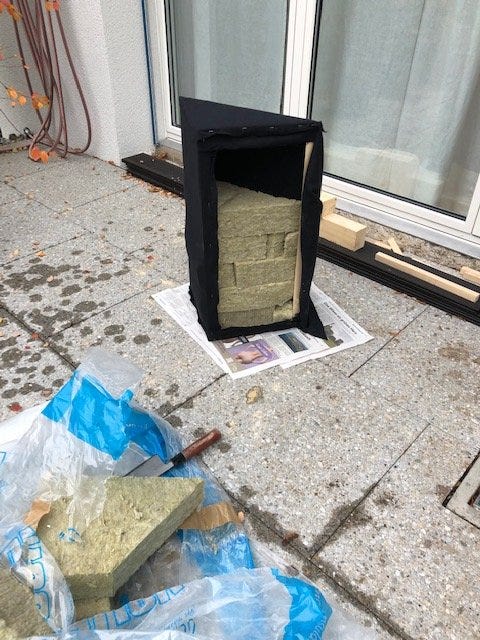
Stone / mineral wool filling Finished
In this way, five absorbers found their way into the studio in no time at all. Four of them can be seen in the picture below (two each on the left and right in the corners). The fifth, somewhat larger corner absorber is in a corner of the room behind me (not in the picture).
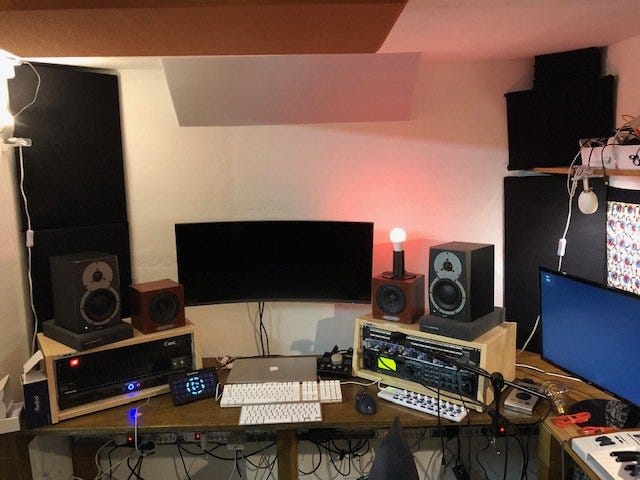
-
DIY Eckabsorber (Bassfallen)
Einfache Eckabsorber selbstgemacht.
English version: https://mark-evertz.medium.com/diy-basstraps-5e96bb24a8c3
Mittlerweile hat sich hoffentlich rumgesprochen, dass Eierpappe Räume nicht wirklich akustisch aufpäppeln kann. Insbesondere tiefe Frequenzen sammeln sich gerne, wie Staubflocken, in den Raumecken und türmen sich zu unliebsamen Wellenbergen auf (Raummoden https://de.wikipedia.org/wiki/Raummode#:~:text=Raummode%20(von%20englisch%20room%20mode,befindlichen%20Menschen%20von%20Interesse%20ist).
Als letzte Phase meines DIY-Projekts zum Bau einer Schallschutzkabine (https://mark-evertz.medium.com/diy-acoustic-booth-3dff20a380b3) war mir die Raumakustik ein Anliegen. Jene den Höreindruck verfälschenden, und daher nervenden, Raummoden (kennt man auch als stehende Wellen), wollte ich mittels Eckabsorbern (Bassfallen o. Basstraps) in den Griff bekommen.
Ich bin dabei weniger wissenschaftlich als pragmatisch vorgegangen. Akustisch Messungen und Berechnungen zu Grösse, Volumen und Material optimaler Absorber habe ich mir gespart und lediglich auf Restmaterialien aus meinem Studiobauprojekt zurückgegriffen. Ob mein Nehmen-Was-Da-Ist bzw. Besser-Als-Nix Ansatz erfolgreich ist, werde ich mit einer späteren Akustikmessung noch prüfen.
Wer sich ausführlicher mit dem Thema beschäftigen sei folgender Artikel empfohlen:
https://www.bonedo.de/artikel/einzelansicht/raumakustik-workshop-no1-eckabsorber/2.html
Das Grundgerüst
Die Basiskonstruktion besteht aus einer 1cm quadratischen Schichtholzplatte, die ich in zwei gleichschenklig-rechtwinklige Dreiecke (25x25cm) gesägt habe. Auf diese sind 1cm dicke Kanthölzer verleimt und geschraubt (Vorbohren nicht vergessen). In die spitzen Winkeln fügen sich halbierte Kanthölzer (dreieckige Grundfläche), die man man fertig zugesägt im Baumarkt bekommt.
Da meine Absorber max. 75cm hoch sind, brauchte ich keine Querstreben zur Versteifung. Ich denke ab ca. 100cm wird’s allmählich wackelig.
Da auf den Fotos die Form der Kanthölzer nicht gut zu erkenne ist, habe ich einen kleine Skizze mit SketchUp (https://www.sketchup.com/) angefertigt.


Skizze (SketchUp) der Grundelemente Hülle
Ummantelt habe ich die Absorber mit dickerem Baumwollstoff (Molton: Gewicht: ca. 160 g/m), den ich als Meterware hier bestellt habe https://basteln-ch.buttinette.com/shop/a/baumwoll-flanell-schwarz-57929.
Pi-Mal-Daumen zugeschnitten und unter Spannung an den Rahmen getackert, sitzt der Stoff wie angegossen. Damit es ein Bisschen hübsch wird, habe ich den Stoff nur an die kurzen, hinteren Seiten Getackert. Vorne sind dann keine Klammern zu sehen.



Stoffbahnen aus Molton (Baumwolle) zuschneiden Füllung
Mineralwollreste habe ich zur Füllung verwendet. Gegenüber anderen Materialien lassen sich Mineralwollplatten sehr einfach passgenau zuschneiden.

Füllung aus Stein-/Mineralwolle Fertig
Fünf Absorber haben auf diese Weise im Handumdrehen den Weg in’s Studio gefunden. Vier davon sind auf dem Bild unten zu sehen (jeweils zwei links und rechts in den Ecken). Der fünfte, etwas grösser ausgefallene Eckabsorber, ist in einer Raumecke hinter mir (nicht auf dem Bild).

Bassfallen In den Raumecken platzieren
-
DIY — acoustic Booth
German: https://mark-evertz.medium.com/diy-acoustic-booth-3dff20a380b3
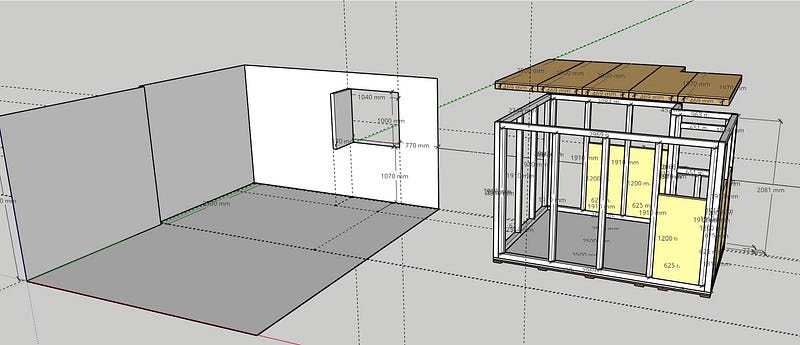
Here we go …
Practicing, mixing tracks and listen to music until it rattles — whenever I like. Traveling through half the city to the rehearsal room to spare the nerves of my roommates and is no longer the preferred option. To indulge in the self-made noise to your heart’s content would be a thing. At this stage someone usually raises the question about headphones: “Yes, no but …” I need a soundproof cabin! PERIOD.
Egg carton and carpets are not enough. A room-in-room construction that largely keeps my sound events away from the outside world should increase my quality of life.
After thinking probably 100 times back and forth whether I should buy a finished product (e.g. http://www.studiobox.de => sack expensive!), building by myself, or let it go and continue to complain, I decided to do it myself try (Yippiejaja). Problem: My craft experience is close to zero.
Various online forums have given me courage and inspiration. Finally, at the end of December 2019, this colleague (Callisto) DIY — Drum Cabin convinced me of the feasibility. Without information from the digital world, I would be stuck.
Virtual walking tests with the help of http://www.sketchup.com gave me first impressions of the construction and materials (as well as quantity and weight). In fact, it was necessary to do some project planning: Ordering stuff indiscriminately that I can’t store or have no space to work afterwards would not be expedient 🙂
I also had to think about the construction in advance. First the side walls and then the ceiling, or the ceiling in modules and after erecting the walls, pushing the ceiling from the side on top (how much space do I need to change something on the ceiling from above?)? Questions after questions 🙂
The Room
In addition to my apartment, I have rented a craft room that is supposed to serve me as a studio. However, I never feel completely free in it. The concern that my fellow human beings potentially listen to my strumming reluctantly influences my game. The room is currently home to various devices, along with guitars, cables, stands, etc., and serves more as a warehouse. That should change.
Since the room is rented, I don’t want to make any structural changes. I also have to consider the weight of the construction, since the room is not on the lowest level of the house — it is not standing on the ground. Common building standards are around 1.5–2 kn / m2 (roughly translates to 150–200 kg / m2).
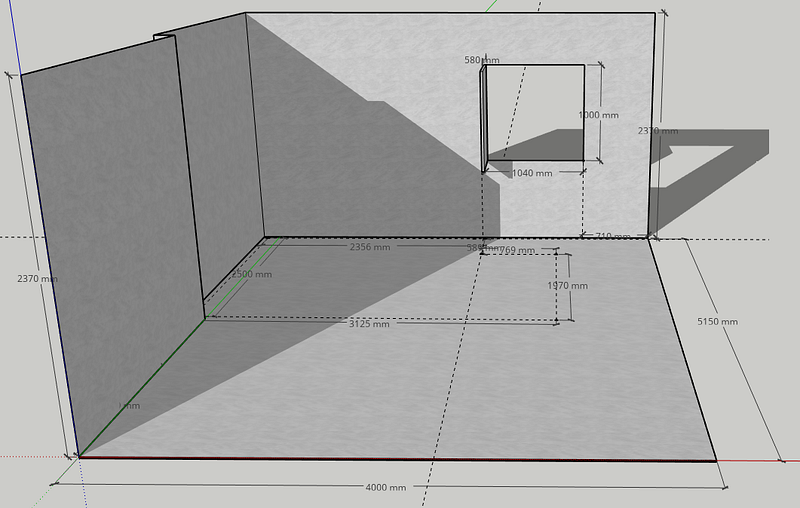
Sketch with the floor plan of the sound cabin. The entrance door to the room is on the front right (not shown). The dimensions of the floor space result from a compromise between requirements, weight, difficulty of construction and conditions of the room (windows, varying ceiling heights, etc.). After all, I have about reasonable 7.5m2 (external dimensions) to make noise. The 7.5m2 allow me about 1125–1500 kg / m2 payload to build the cabin.
The knowledgeable observer does not overlook the fact that I ignore the no parallel sidewall principle. Optimal room acoustics is not priority 1 in my case. I preferred a simpler construction and will measure and treat the room acoustically later.

13.02.2020 The first delivery of materials Basics
The floor of the cabin is constructed in three layers:

Three-layer floor: Sylomer, OSB, screed elements The bottom layer consists of 6 strips of polyurethane plastic — Sylomer (2500mm, 25mm, 125mm). It serves to decouple the construction from vibration. The sound cabin “floats” on this rubber mounting and uses a mass-spring system, as used in railway technology, to prevent sound events in the cabin from resonating in the rest of the world. The rubber strips are the only points of contact between the cabin and the outside world.

07.02.2020 Trial laying of the Sylomer strips Sylomer is produced in different variants, as required with regard to damping and load. It is manufactured by RRG in Germany and can be ordered here: https://www.baubedarf-spezialartikel.de/. I use the standard strips: Sylomer SR 18, 0.018 N / mm² 25 mm. 0.018 N / mm² corresponds to approximately 1800kg / m2… should be enough.
I filled the space between the Sylomer strips with 40mm mineral wool (not shown in the model). The weight of the upper layers compresses the wool so that the cabin lies on the rubber strip at the end.

02/13/2020 The first layer of Sylomer and rock wool I used five 22mm thick, 650mm wide and 2500mm long OSB 3 chipboards for the base plate. Four plates lie across, one in length (right) on the Sylomer strip.

Thanks Dave 🙂 The panels are glued together on tongue and groove. For the contact pressure, I screwed angle connectors onto the plates and pushed them together using screw clamps.
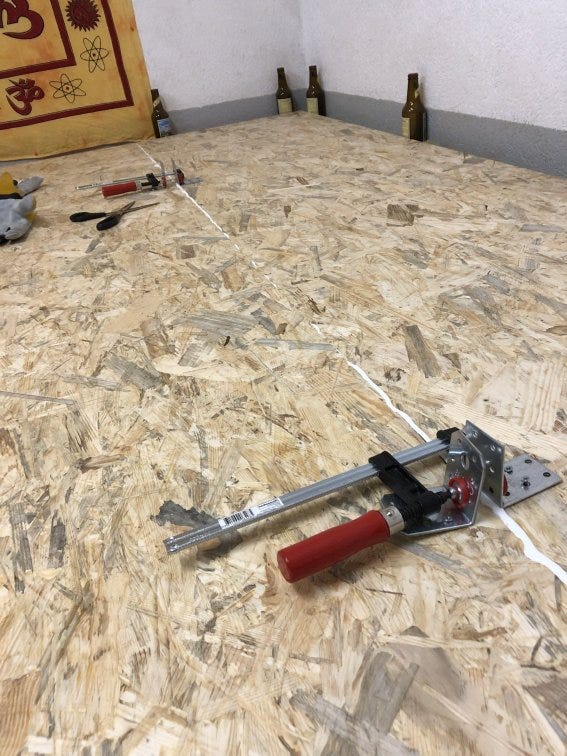
02/14/2020 The second layer: glueing 22mm OSB 3 boards The third, mass-bringing layer, consists of Fermacell screed elements with an additional 10mm rock wool layer (no idea whether that will bring what?).

15.02.2020 The third layer of the floor slab consists of Fermacell screed elements The screed elements are laid fluently and must be sawn accordingly. This is quite a mess (respiratory protection!), Which has brought my vacuum cleaner beyond: — |.
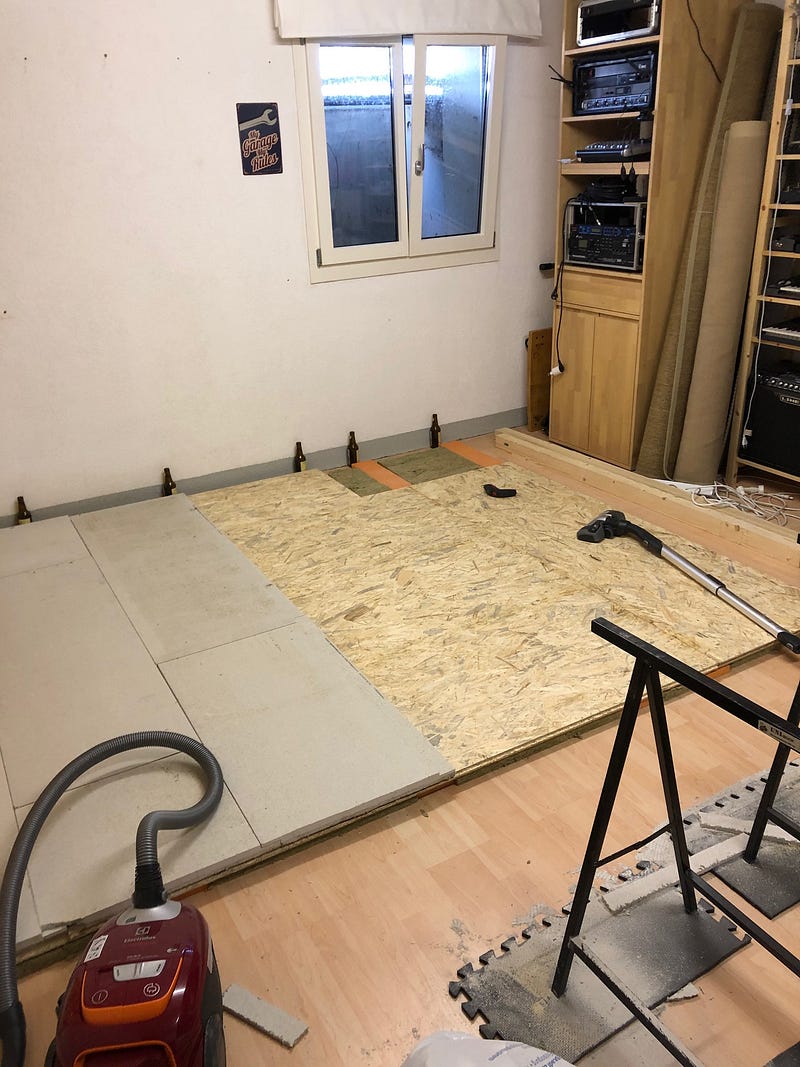
02/15/2020 Cutting and trial laying of the screed panels Attention: Before ordering the plates you have to take the exact dimensions into account. The plates are specified with 1550mm x 550mm. However, they are laid 50mm overlapping. The 50mm fold of the panels on the outer edges is sawn off. This means that the panels are only 1500mm x 500mm in size. I had ordered one panel in addition— I was lucky!
The saw blade is a somewhat coarser but normal blade for woodcuts. I can highly recommend a guide rail as used for circular saws. With an additional adapter for my jigsaw, it worked great. The joyful excitement about my newly acquired skills would have made my sawing edges artful without this utensil, but guaranteed not to be straight.
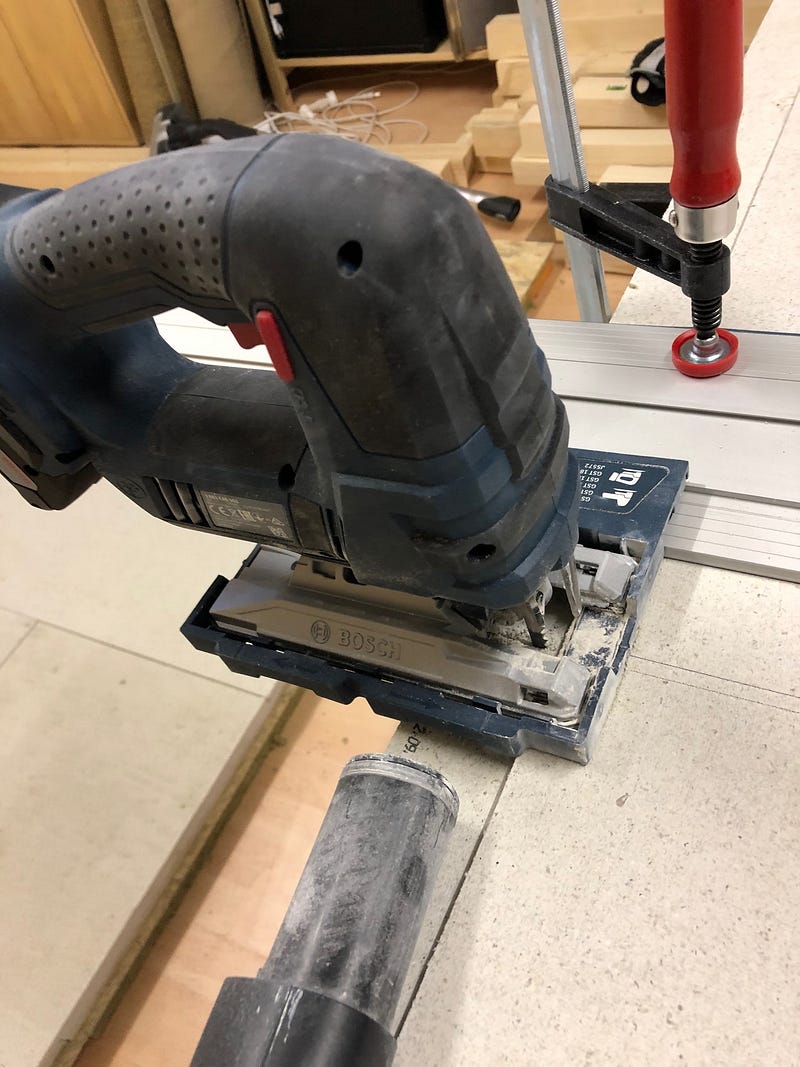
15.02.2020 To ensure that the panels close well and no longer slip, they are glued with a special adhesive and fixed with quick-assembly screws. The latter prevents the hardening adhesive from pushing up the panels.

02/21/2020 Glueing and screwing the screed panels Finally: The finished laid, glued and screwed base plate. On the right you can already see the wooden frames for the first side wall.
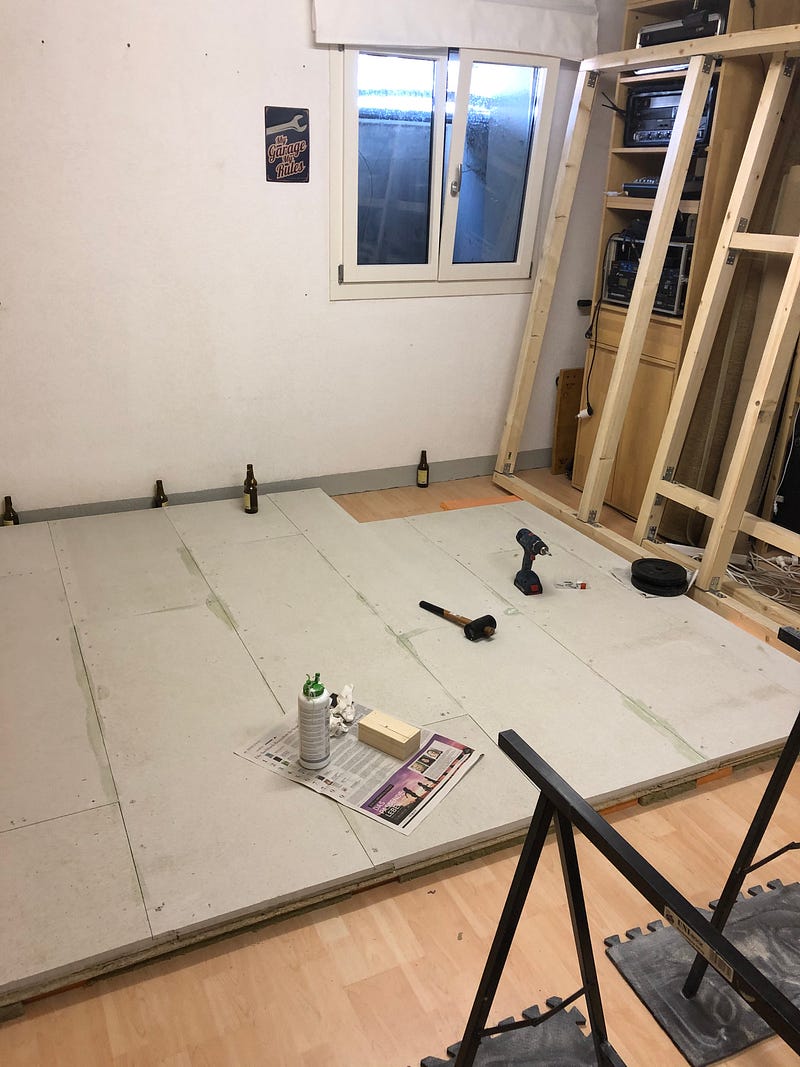
02/21/2020 Done (except for joints to be filled)
Construction of Walls
The structure of the sound cabin is constructed as a wooden stud frame. The frames of the walls consist of 60mm x 80mm squared timbers, which are screwed to 80mm x 80mm corner posts (6 of them). I use the less thick squared timber for the frames to save some weight.
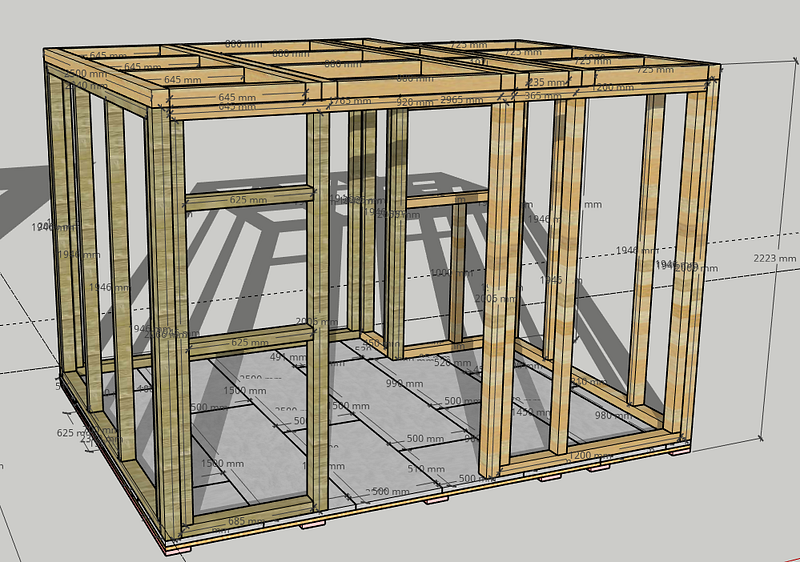
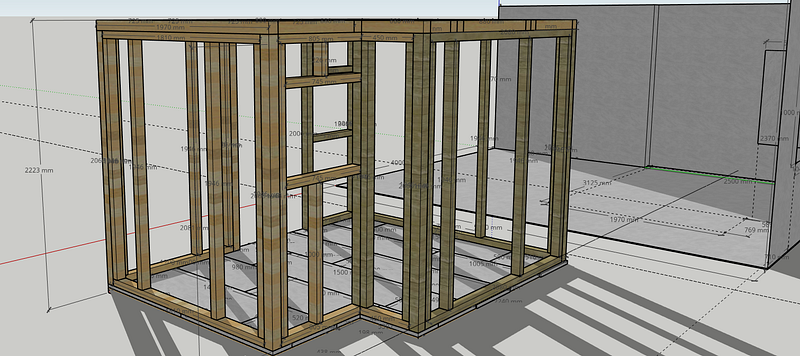
Rear view with placeholder for a window I ordered the beams for the side walls online (Hornbach) and had them cut to size. Various opinions can be found in various forums. Some have had good and bad experiences regarding the quality of the wood and the accuracy of the sawing work and therefore recommend selecting the beams in the hardware store yourself and sawing them yourself. My experiences are thoroughly positive. The cut is accurate to the millimeter as ordered and no bar was crooked or of unsatisfactory quality. The time saved by the already sawn timber is considerable. In addition, you reduce the noise pollution of the environment (unless you have a soundproofed room in which you make noise …).

02/22/2020 Assembly of the first side wall 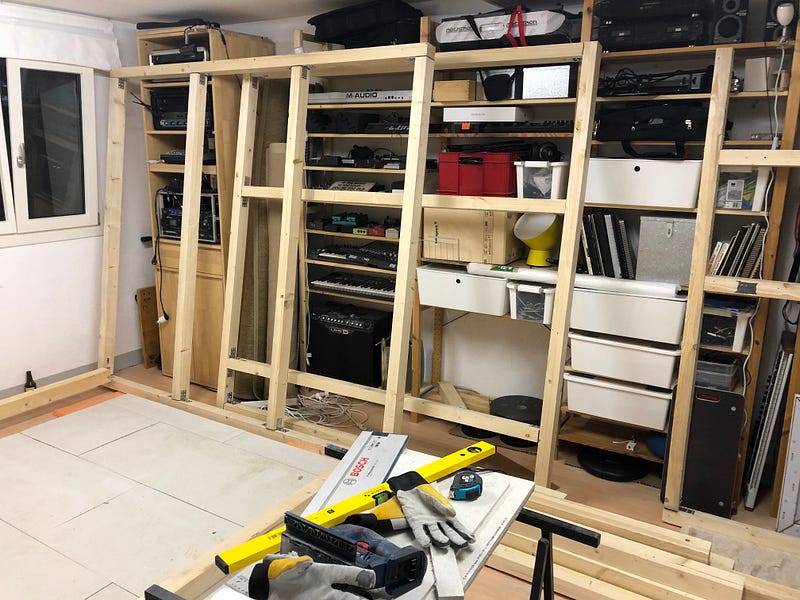
20.02.2020 Construction of the walls, which I have to plank from the outside before assembly The woods are connected via metal angle connectors and 3.5x40mm screws (pan head). Anyone tell me why 90% of all screws are countersunk screws? What a shit solution if you want to use them with angle connectors!
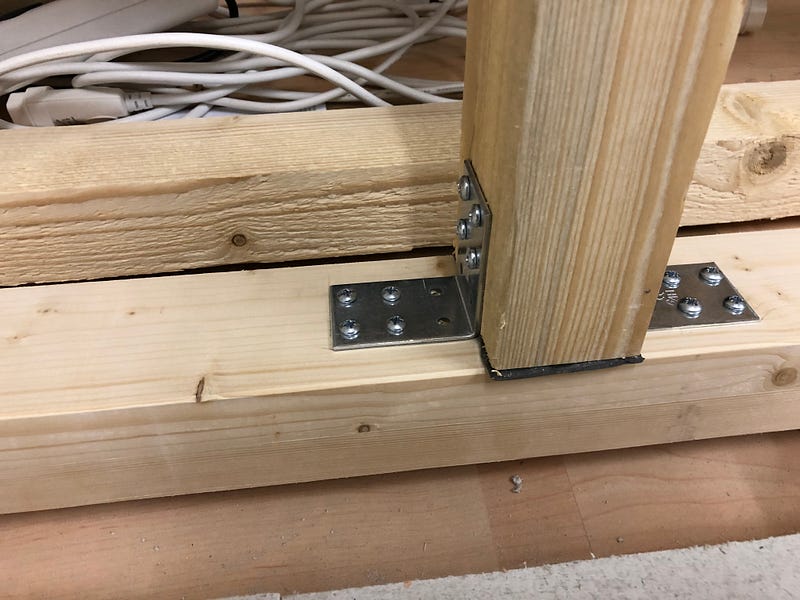
20.02.2020 Angle connectors and rubber seal I glued all the posts and struts with sealing strips at their vertical contact points. This also applies to horizontal beams in contact with the Fermacell panels. I hope that this will result in less wood-on-wood creaking and secondly an additional acoustic decoupling (look here). Incidentally, the scaffolding is not screwed or glued to the floor.
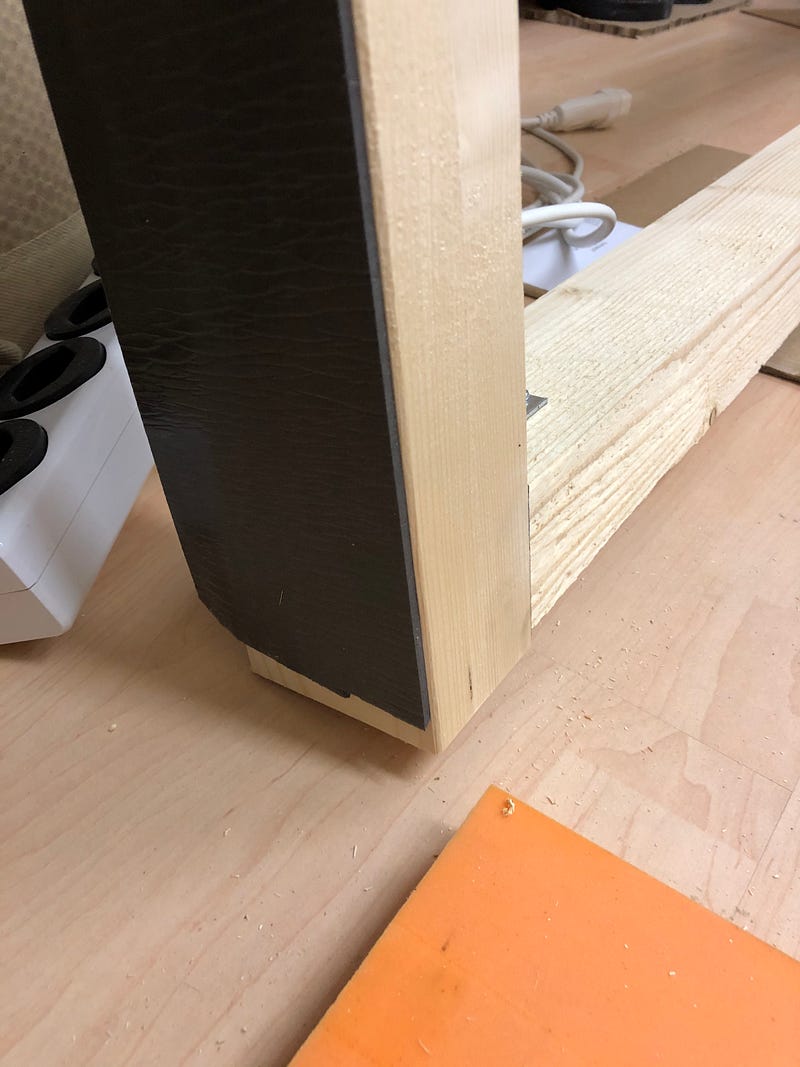
02/23/2020 Horizontal beams that will stand on the floor are covered with sealing rubber I carried out the planking of the walls that are close to the outer walls while lying down (so not me, of course …). I used OSB 3 boards 625x2050x15. I would have preferred 22mm plates, but I had to keep an eye on the total weight. If the degree of absorption is not sufficient, I will make the interior paneling correspondingly stronger.

02/22/2020 External planking of the first side wall with 15mm OSB 3 panels 625x2050x15 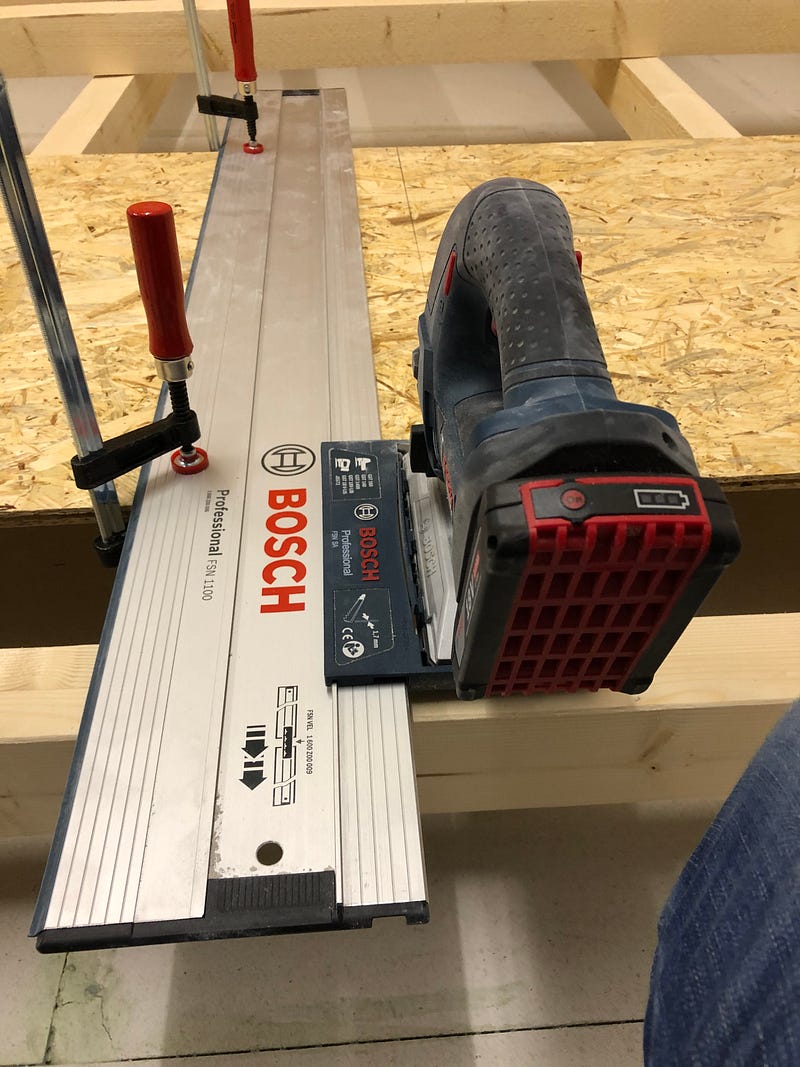
02/22/2020 A blessing — guide rail plus adapter for jigsaw! 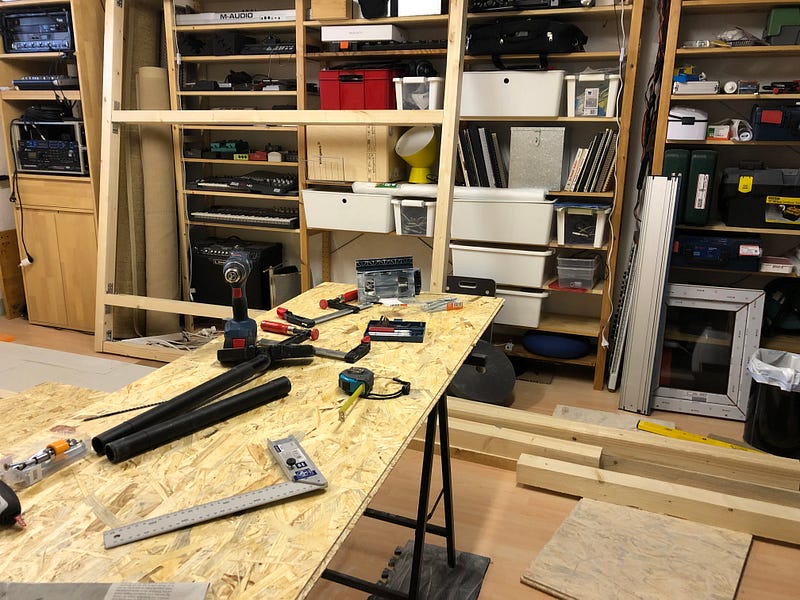
02/22/2020 Impression 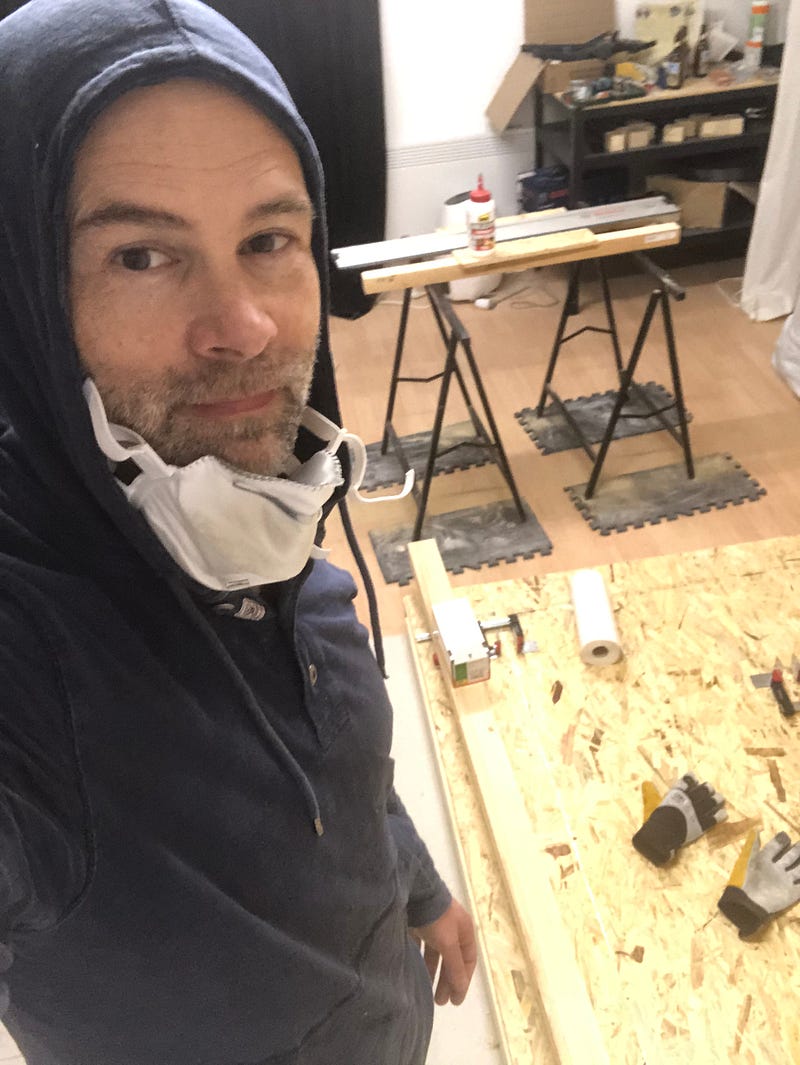
02/22/2020 Me The panels are glued on tongue and groove and, as before, pressed together on the floor with angle connectors and clamps. I then fixed the plates with 5x40mm countersunk Torx screws — no further glueing of the boards to the beams.
So that there are no joints and audio snippets do not find a way out, I will later seal all connection points (boards / beams, beams / floor, beams / beams) with acrylic.
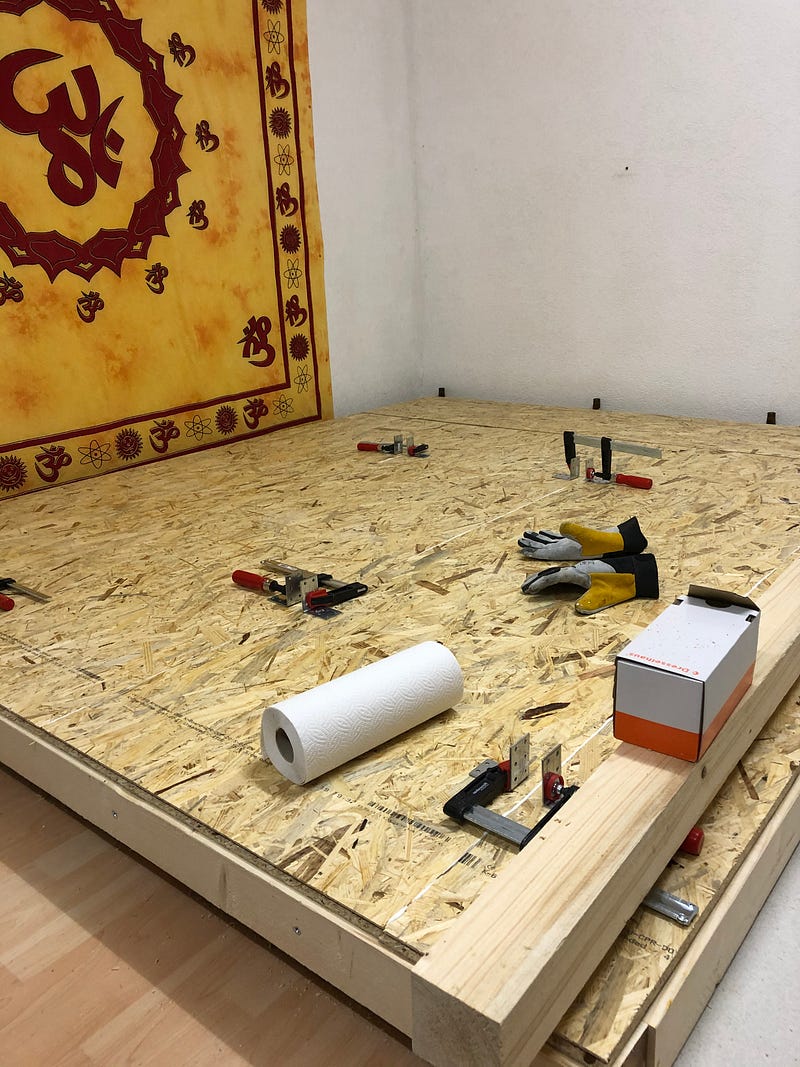
02/28/2020 Glued, screwed, pressed … 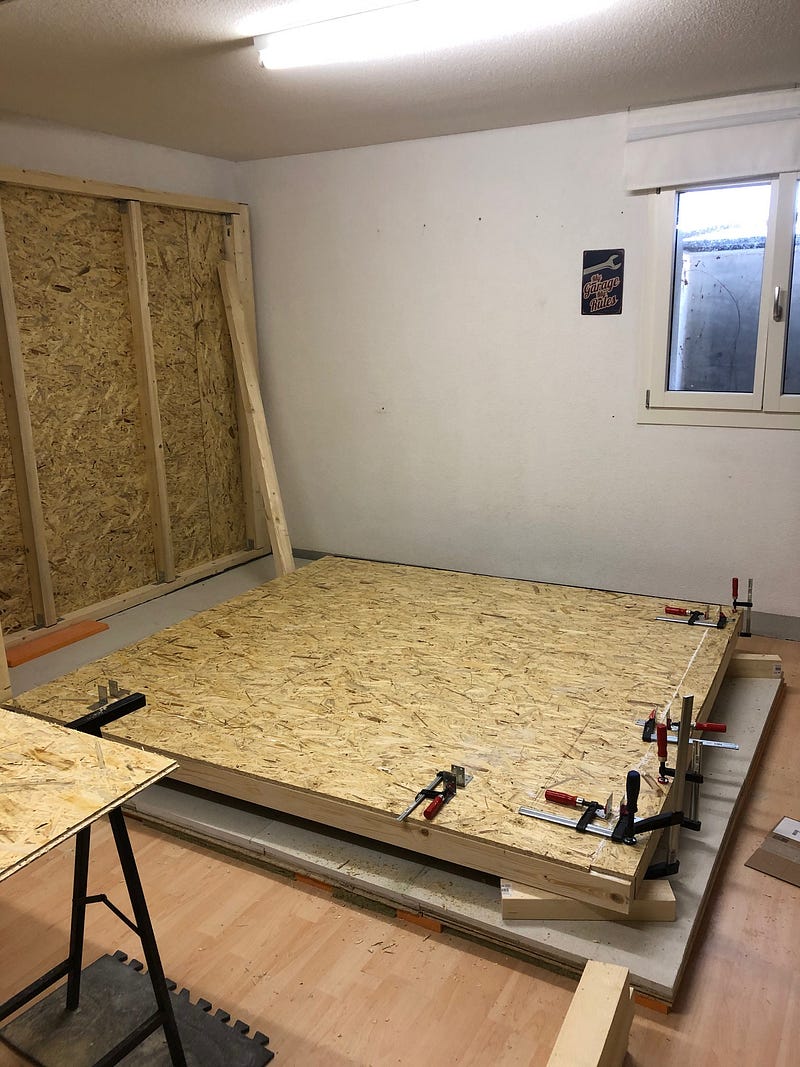
02/28/2020 The first wall is provisional 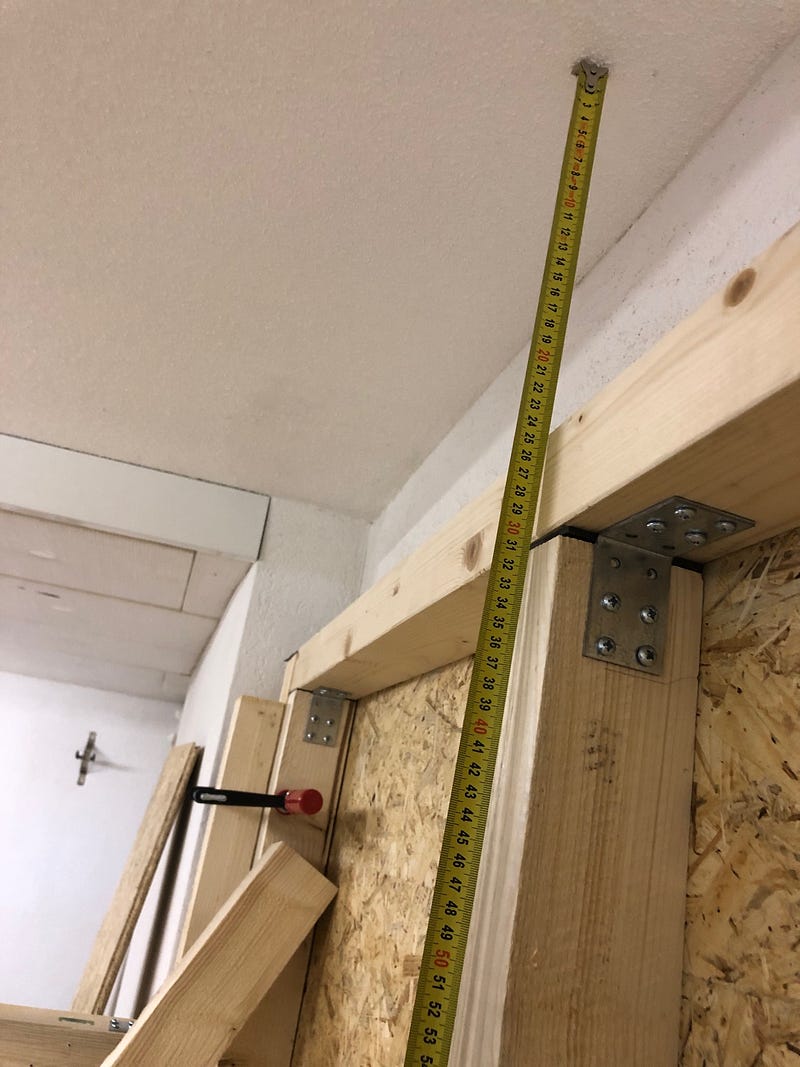
02/24/2020 Fits! As in the model The walls are connected to each other via corner posts and 6x12mm countersunk screws. Nothing works here without pre-drilling. First I pre-drilled about 30–40mm with a 3mm drill with milling for the countersunk head, then I widened the hole about 50–60mm deep with a 4mm drill and then pre-drilled almost the entire screw length with a 3mm extra long drill. Wood drilling is developing into a real passion.
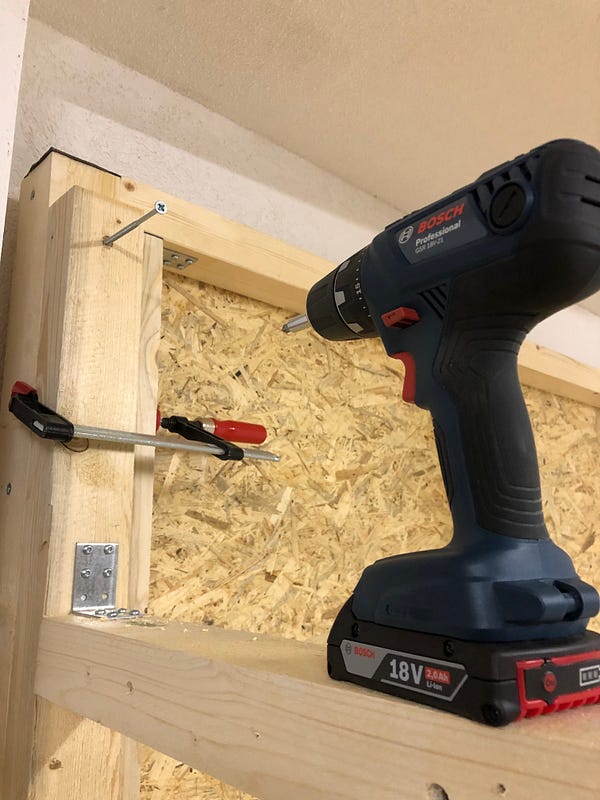

02/25/2020 connecting the side walls 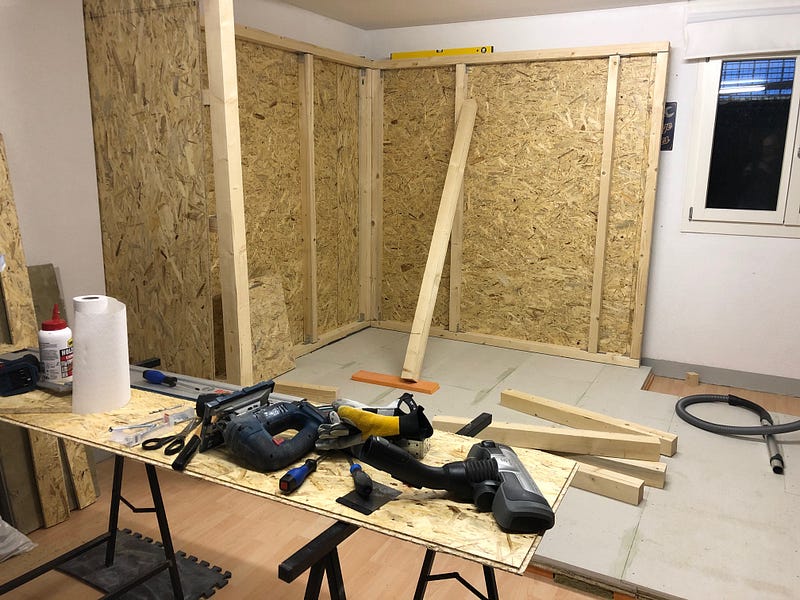
02/28/2020 It becomes stable when the walls are connected at their corners As a final step before I build more walls, the joints in the walls and the floor slabs still need to be sealed. I use acrylic sealant for the panels and beams of the walls, and Moltofill depth filler for the floor panels. Professionals recommend special drywall filler, but you can see from the generosity with which I spread the spatula that I am not a professional 😉
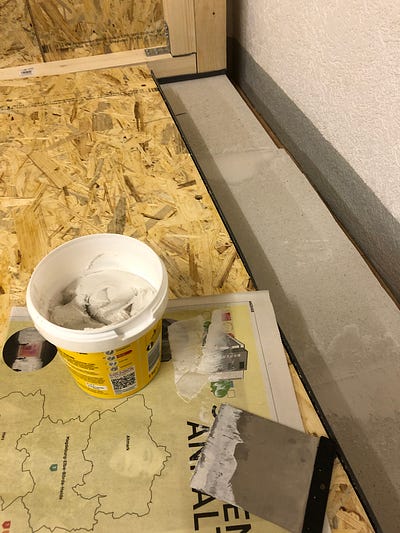
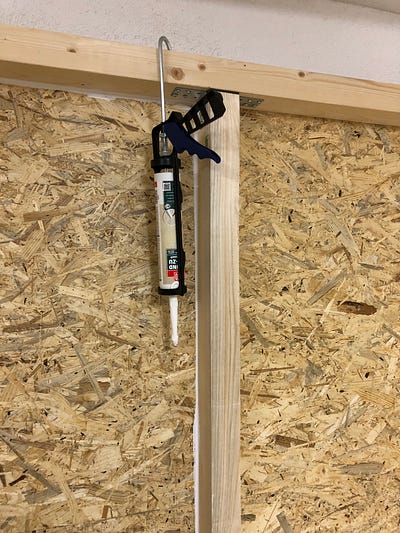
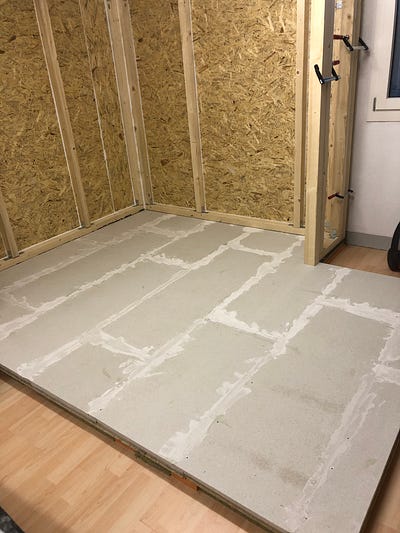
03/01/2020 Make cracks tight
Paradigm Shift
When I mentioned my sympathy for craftsmen with wood in the introduction, I was looking for another justification: namely the supposedly better property of sound absorption from wooden stud walls. However, I recognized the misconception after consulting my favorite book on the subject (table on page 37). Drywall stud frames with metal profiles and plasterboard cladding do a much better job with regard to absorption.
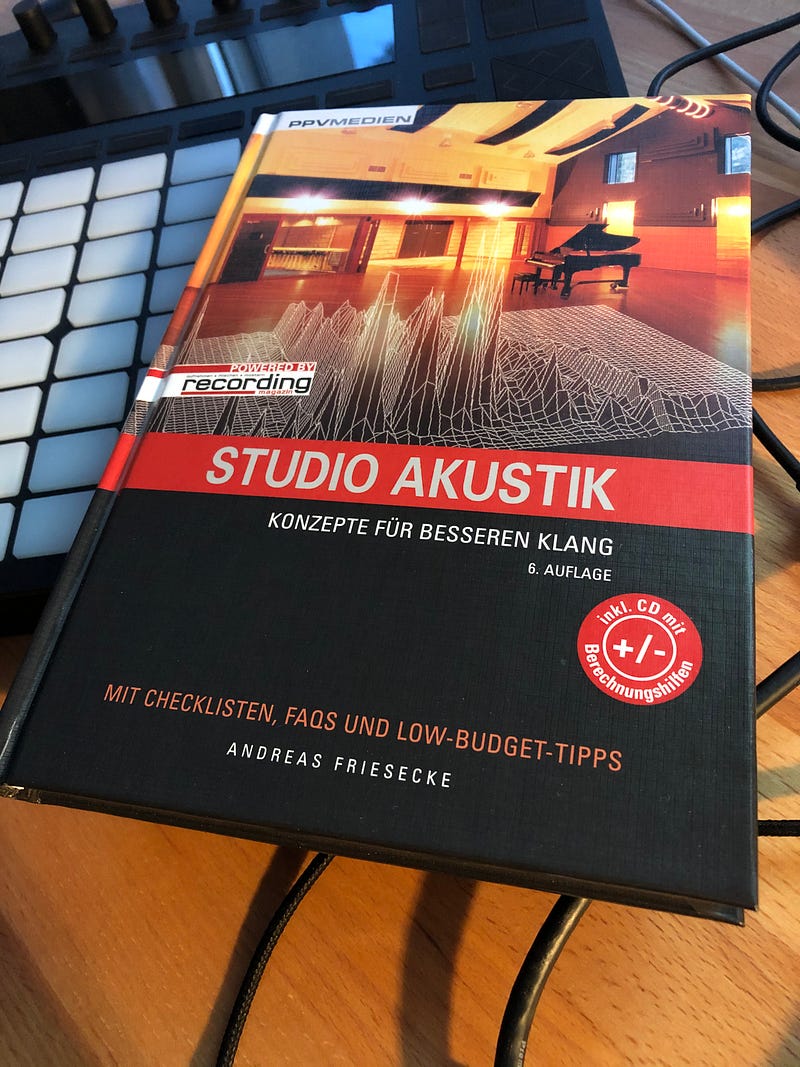
“Must have” — A great read on the topic (I guess, only in german?) Since metal profiles weigh up to 1/4 of the weight of the square timbers used in my case, the saved weight can be invested in additional formwork (more / thicker panels). Cool thing!
However, the different material / system requires different tools and different work steps. Fumbling around is the order of the day and it goes more slowly.
… I still like working with wood 🙂
Stand made of metal profiles as used in drywall
Window-rizing
My first attempts using metal profiles are promising. Gradually I get into the groove of the cutting, bending, sawing and crimping is done faster. What makes me a little queasy is that free-standing walls made of metal profiles are initially less stable and often have to be temporarily fixed during assembly. Overall, it appears that the finished box will not be suitable for playing football or similar in it — nothing is further from me 🙂
Since I am waiting for more material, I started the installation of the first window.
The window that needs to be installed is a triple-glazed 500x600mm prefabricated window from the hardware store. On the one hand, it is supposed to counteract a psychological-negative “jail feeling” and, moreover, to allow access to the outside window. The box is designed so that I can walk around the outside, but that’s not exactly what I always want.
First I put two CW profiles in the window width (+ approx. 5mm air left and right) in the frame. A 2mm UA profile in the middle under the window opening carries the weight. A UW profile, with an excess length of 10 cm left and right and crimped with the CW profiles, forms the lower frame of the opening. Incidentally, the UA profile is not screwed to the floor, but only set with corner connectors (or post brackets). Nothing slips there!
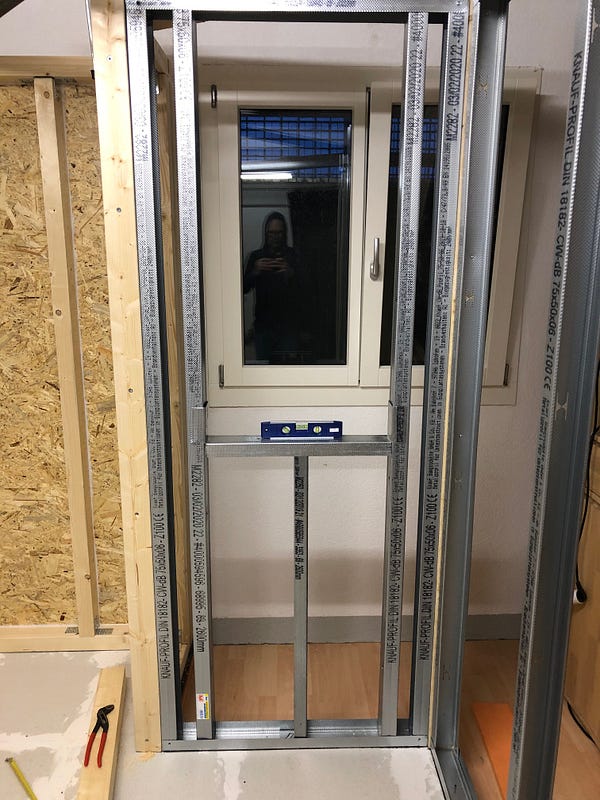
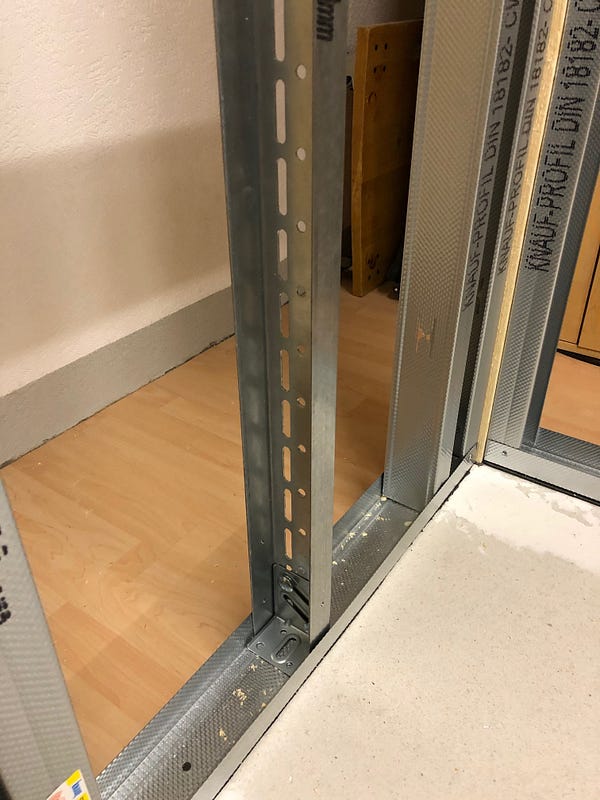
Construction of the window opening from a vertical UA profile and two horizontal UW profiles 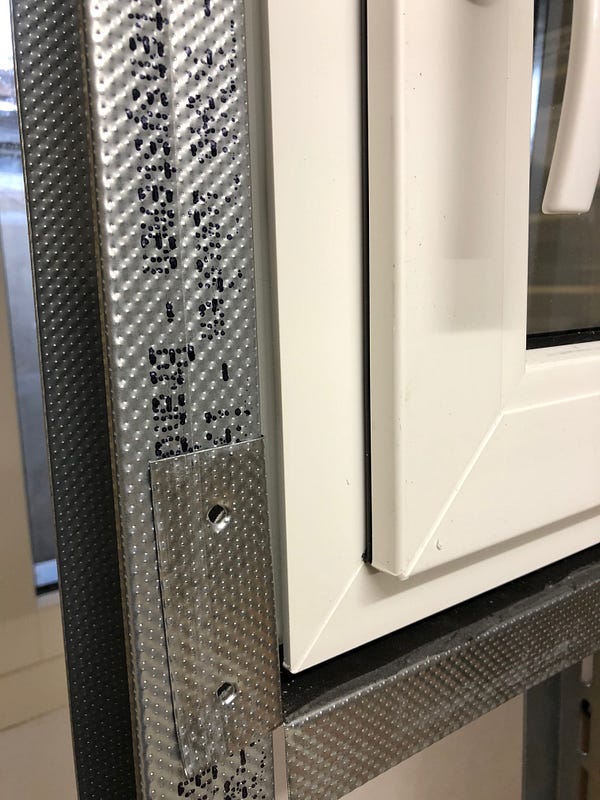

Crimping CW & UW profiles Like the lower frame, the lintel is cut from a UW profile that overlaps 10cm on both sides. In fact, I sawed a longer UA profile later because the window was a little too low for me.
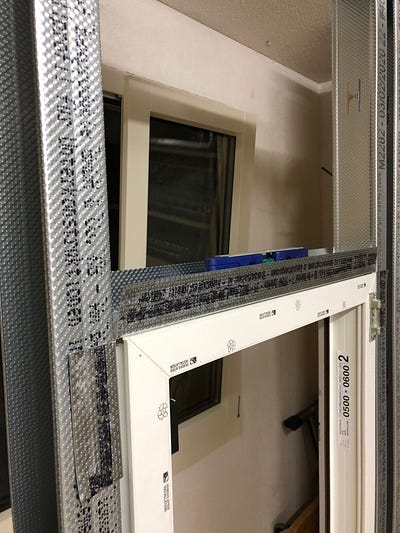
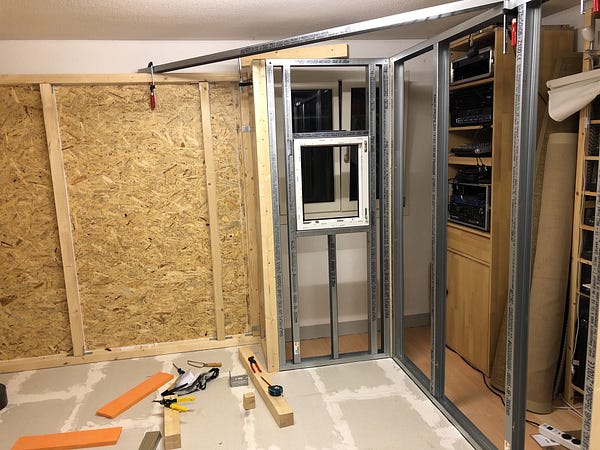

Trial positioning of the window frame I used sealing tapes to fix the window. Once glued from the roll and onto the window frame, the material massively increases in volume, presses the window frame against the metal profiles and thus stays in position. So that the window cannot be pushed through the profile wall, I drilled two holes through the frame on each side and screwed it to the metal profiles with wood screws. So that the screws grip better, I added wooden blocks.

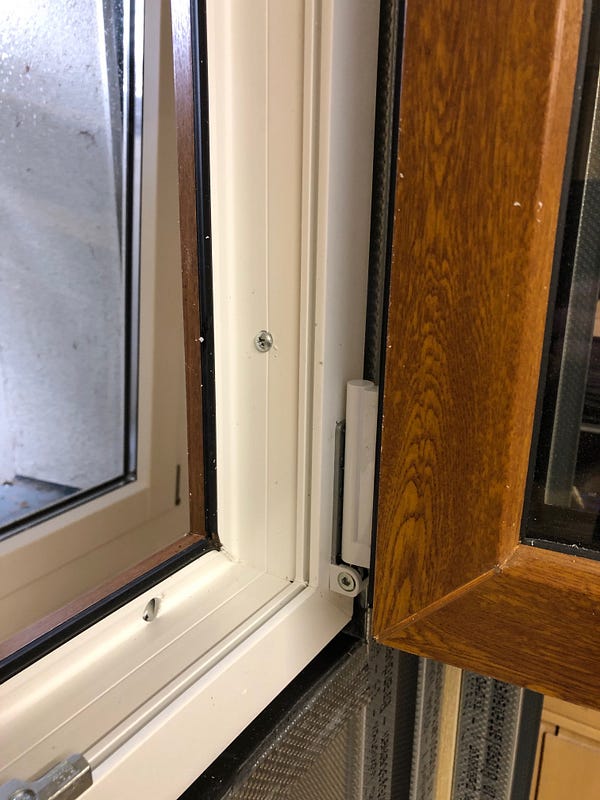
Sealing tapes to fix the frame. Everything vertical! 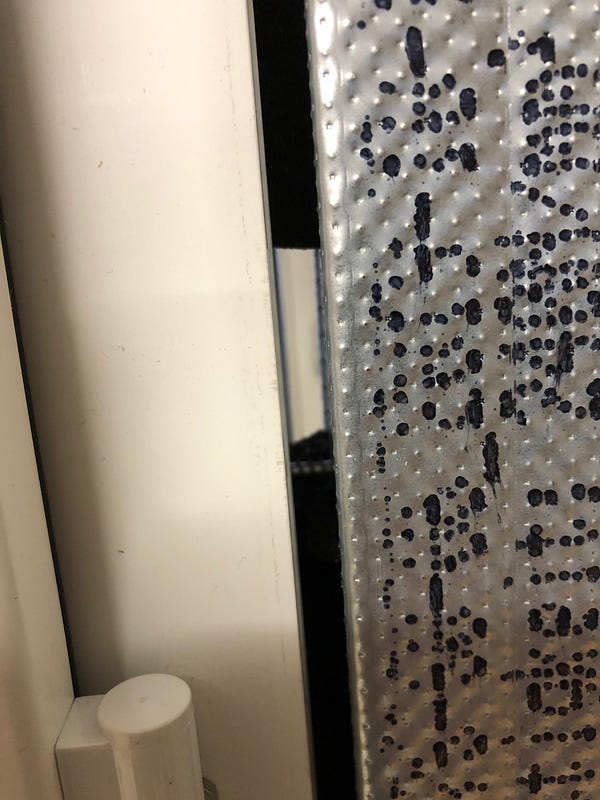
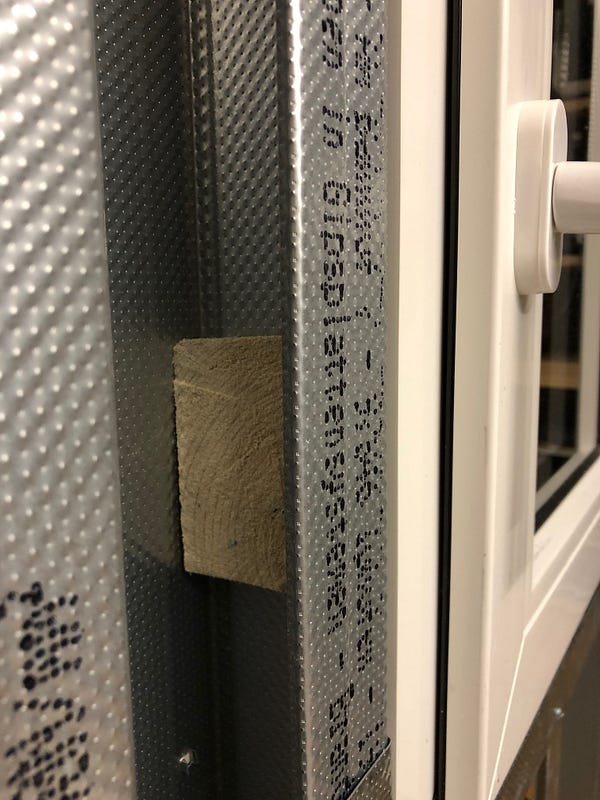
Screw the frame to the metal profiles The only disadvantage is the 100% increased area for window cleaning : -|
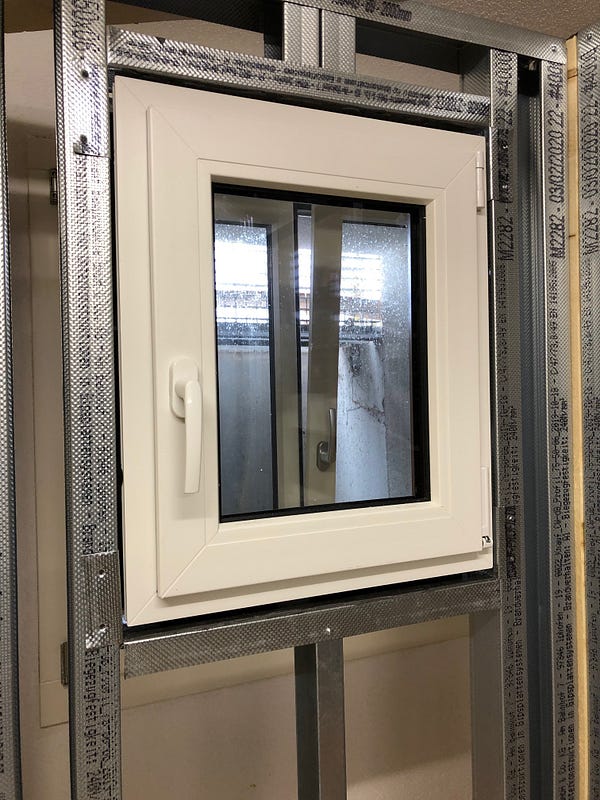

Proud Finally, the windows are firmly connected to the frame with two-component assembly foam. So as not to waste too much of the less environmentally friendly construction foam, I won’t do this before installing the second window and the door.
Profiling
A real difference to working with wood is that the unplanked metal profile walls are initially much less stable and have to be temporarily supported more often. Gazelle-like sneaking on my part is necessary so that the whole clutter does not collapse during assembly (yes, I know you should actually do it in pairs).
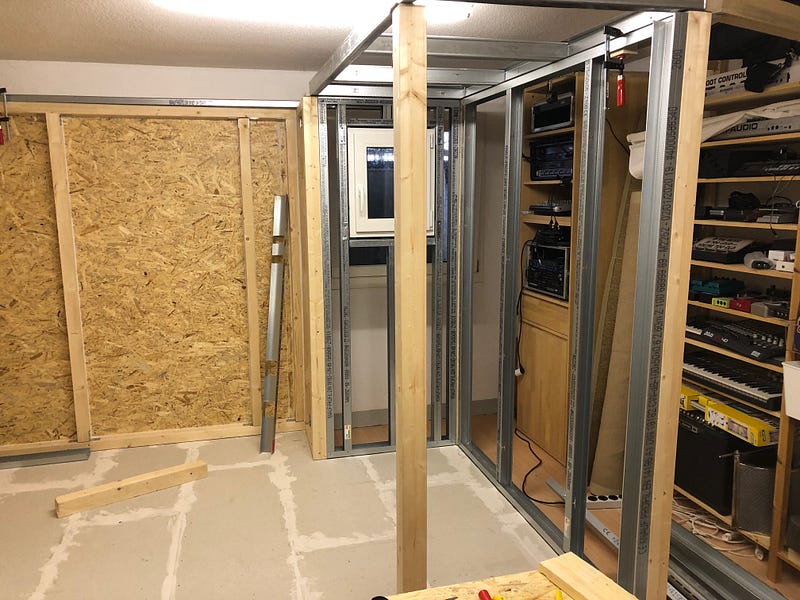
Incidentally, the 2mm stiffening profiles (UA) can no longer really be processed with tin snips. With a hacksaw by hand, or appropriate blades for a jigsaw, it works (nice and slow), but quite well.
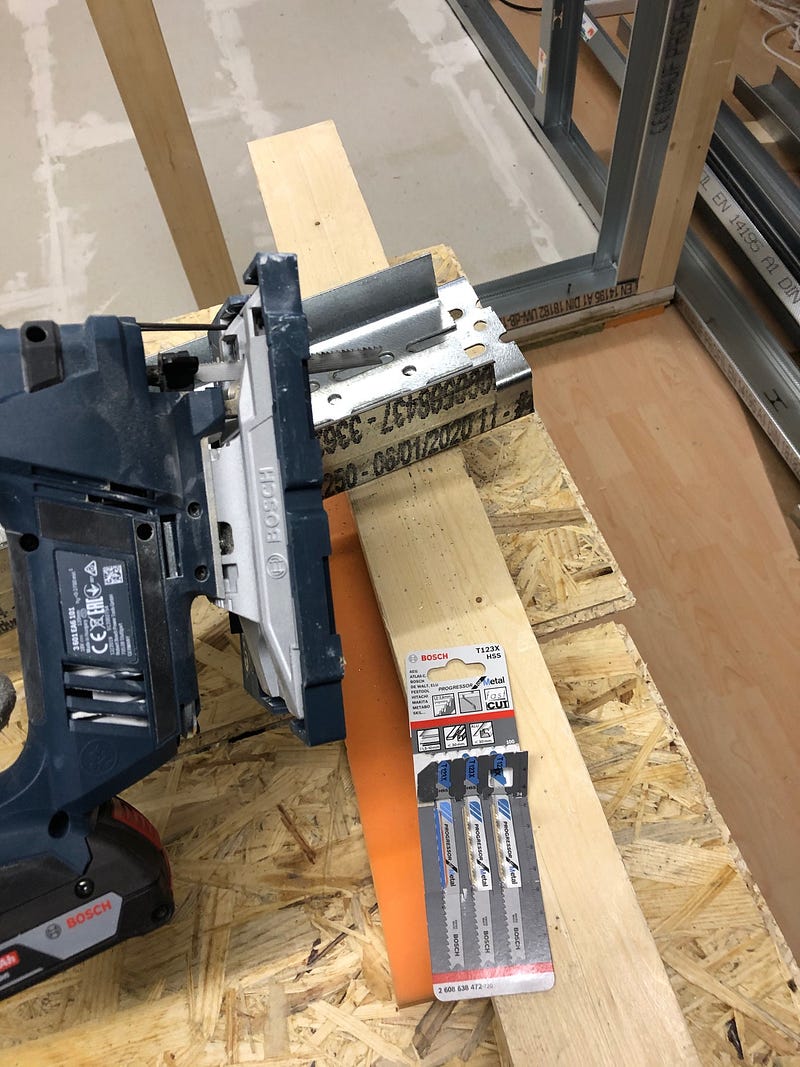
Metalsaw blades for a jigsaw for shortening UA profiles The front wall, which is supposed to house a fire or soundproof door and another window, is constructed with 100mm profiles (in contrast to the 75mm profiles of the ceiling and the other walls).

Modular ceiling design
Since I am no longer the youngest and I have less to oppose gravity than before, I planned the ceiling in modules … Well, that’s partially right. The modular structure is absolutely necessary for reasons of space, and the height of the outside space does not allow me to plank the ceiling from above. A previously completely assembled ceiling plus planking will then actually be far too heavy and very difficult to assemble.
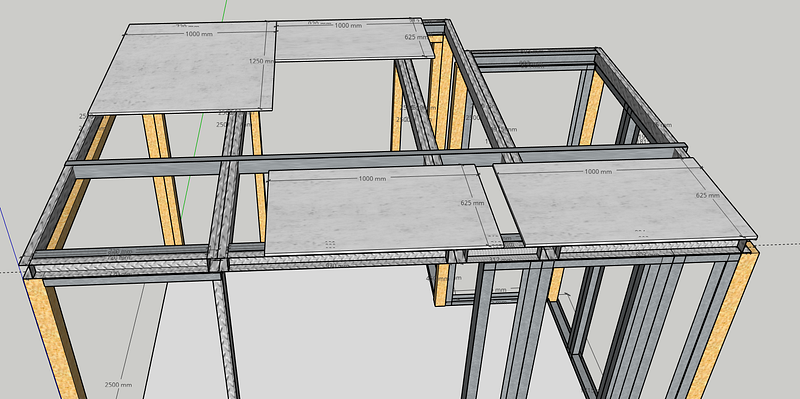
Four ceiling modules The modules are constructed from UW profiles in the longitudinal and CW profiles in the transverse direction (the sketch above is inaccurate). The cutting, bending, screwing, crimping of the metal profiles is progressing slowly — more steps must also be taken into account when constructing ceilings, window cutouts etc. Translated: I have to inspect my work more often, scratch my head, or make more mistakes — which is particularly stupid if I screw up a profile and have to wait for a repeat order. I would have been faster with wood, but the weight savings are considerable and with more routine building with metal profiles will probably have a tempo advantage.

The formwork consists of the same 22mm OSB panels as the floor and is screwed to the profiles with drywall screws. Sometimes the screws do not pull the profiles completely onto the wooden panels and push them away a little. I will later seal these gaps with acrylic.
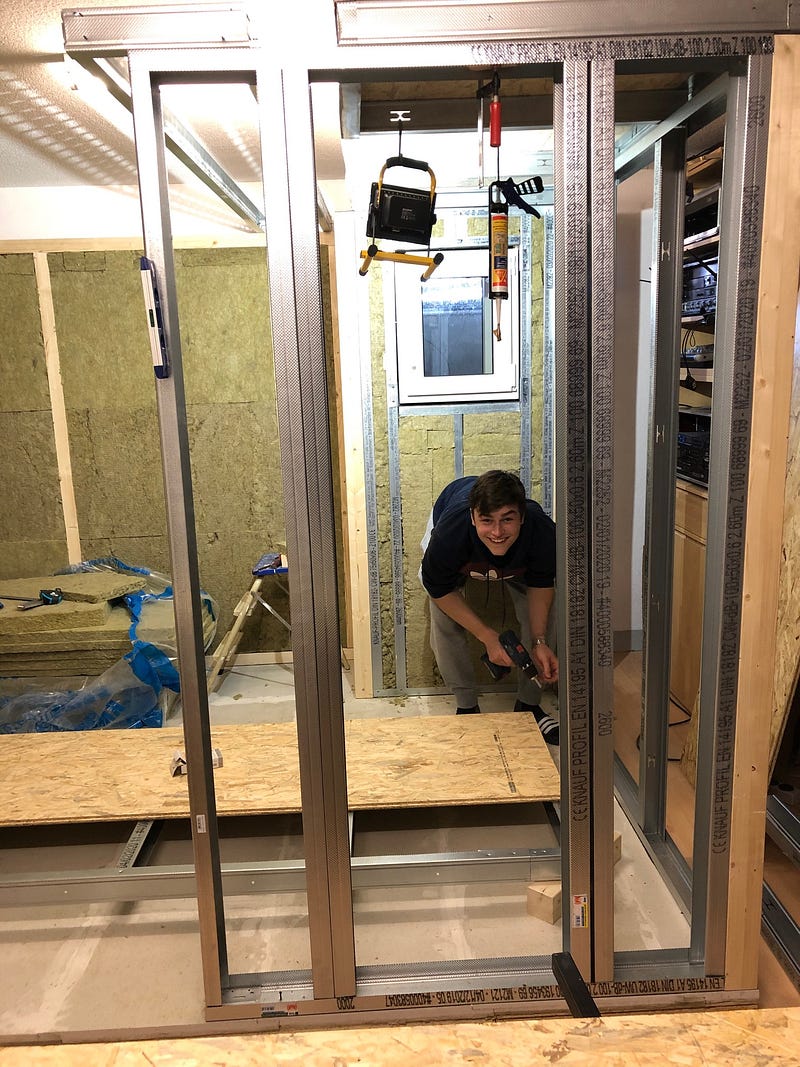
Thank you Kilian 🙂 It is not easy to work with profiles precisely. Despite the greatest care, small deviations have arisen. Some of the ceiling modules are 2–3mm crooked and protrude slightly. I hope to compensate for this with the external formwork, without any negative effects on the insulation.
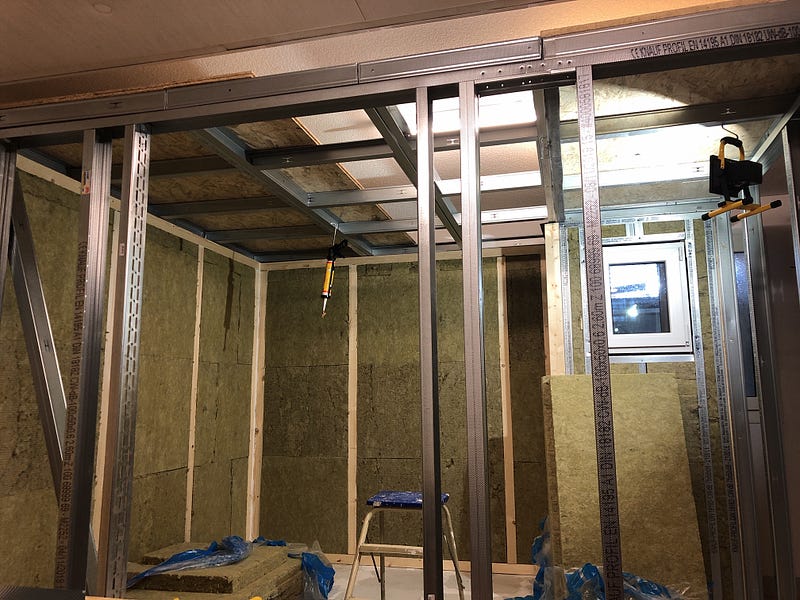
How do I get the ceiling light in the outdoor area if I need to replace it? Inspection hatch, skylight … I have to come up with something else. At least I have provided two cutouts and made a kind of frame with CW profiles filled with mineral wool.
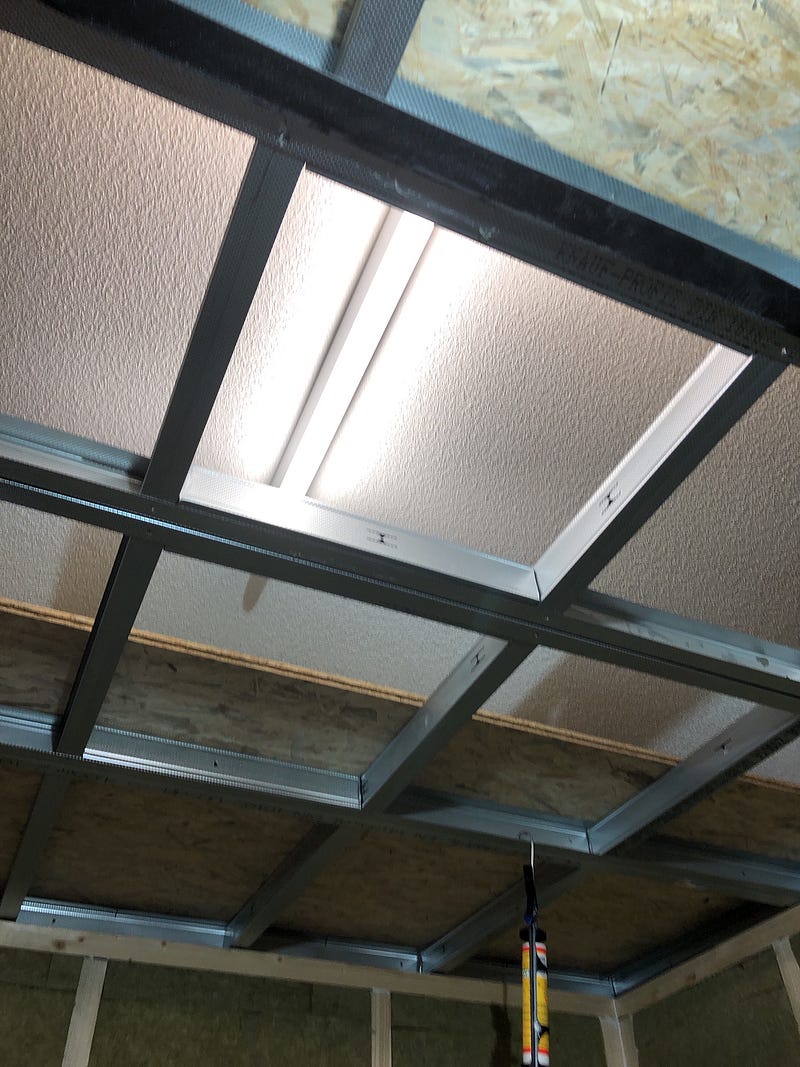
Refreshing
Occasional breathing should benefit from the continuous supply of fresh air. So that this takes place without interrupting the musical activity, soundproof ventilation is required. Somehow, air has to be constantly drawn in and out of the cabin without the sound escaping. The idea that I stole from the aforementioned forum is based on a vertical extension of the ventilation duct.
The construction consists of two shafts: on the left, warm air is drawn out of the cabin from below through a labyrinth, and on the right, fresh air is drawn in in the opposite direction.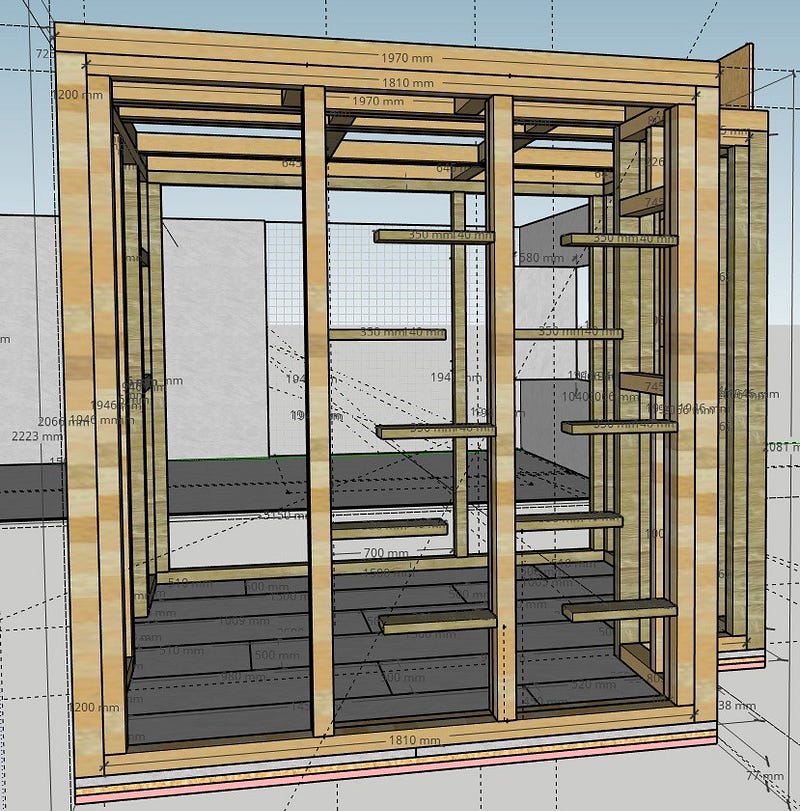
So that something really moves there, the air is sucked out by a radial fan at the top left (outside). The ebmpapst RG 160–28 / 56S fan model runs with max. 2750 rpm and exchanges 202m³ of air per hour. If I ignore the resistance of the labyrinth, the indoor air (approx. 12m³) would be renewed in less than 4 minutes.
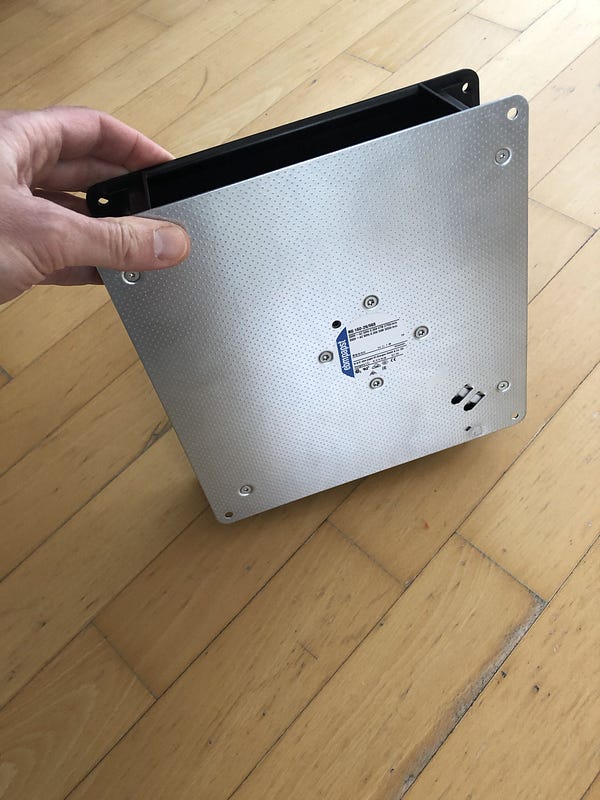
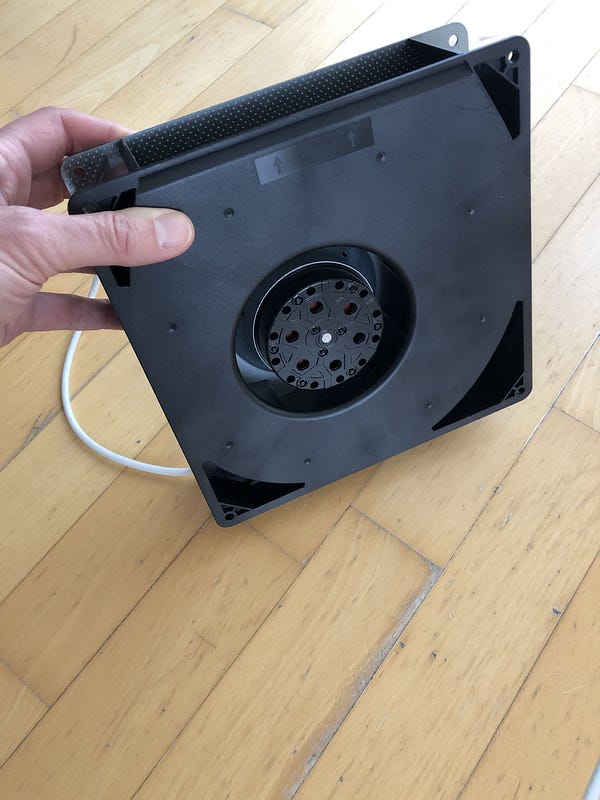
ebmpapst RG 160–28/56S The actual construction differs somewhat from the model. I did not place the two shafts directly next to each other. From the inside perspective, the air discharge will now be seen on the right and the supply on the left.
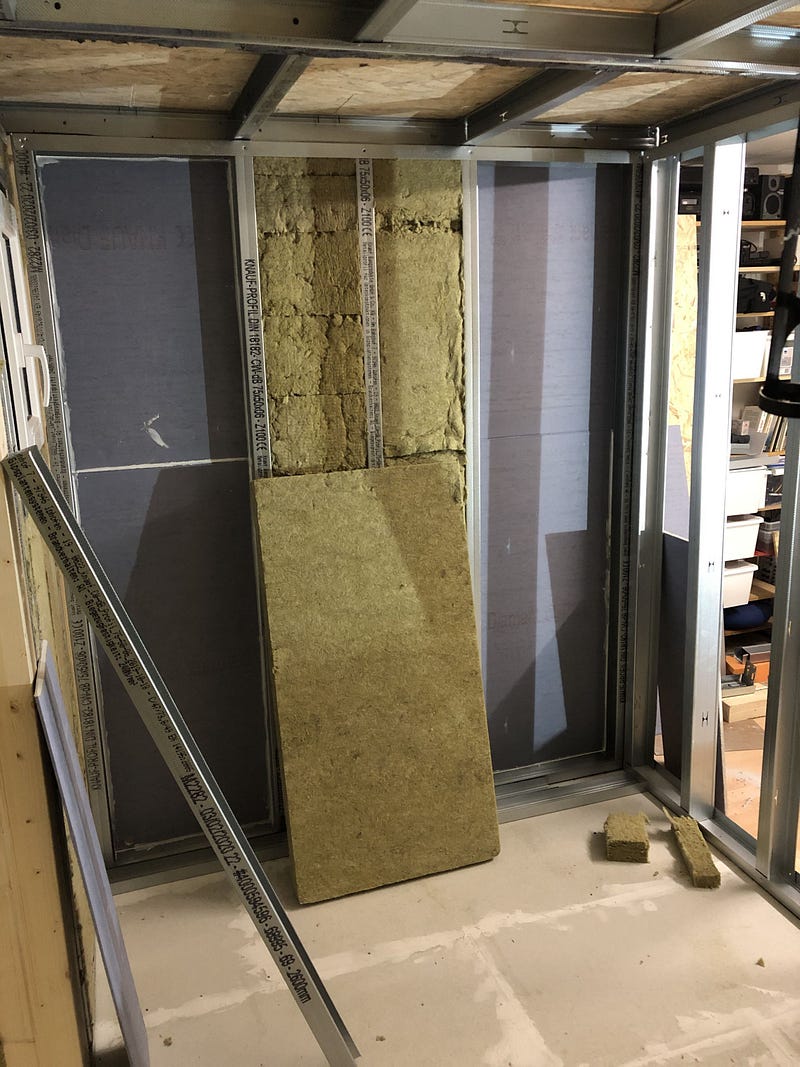
In order to achieve a sufficiently large cross-section for the volume flow, I built a frame from two 75mm two profiles in a row. To do this, I first had to plank this part of the ceiling.
On the right you can already see the glazed wooden frame for my window brand homemade.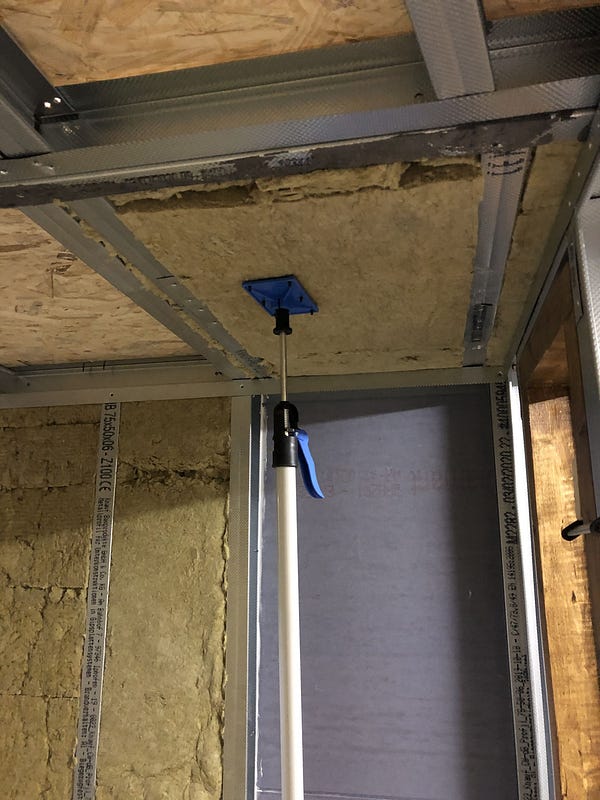
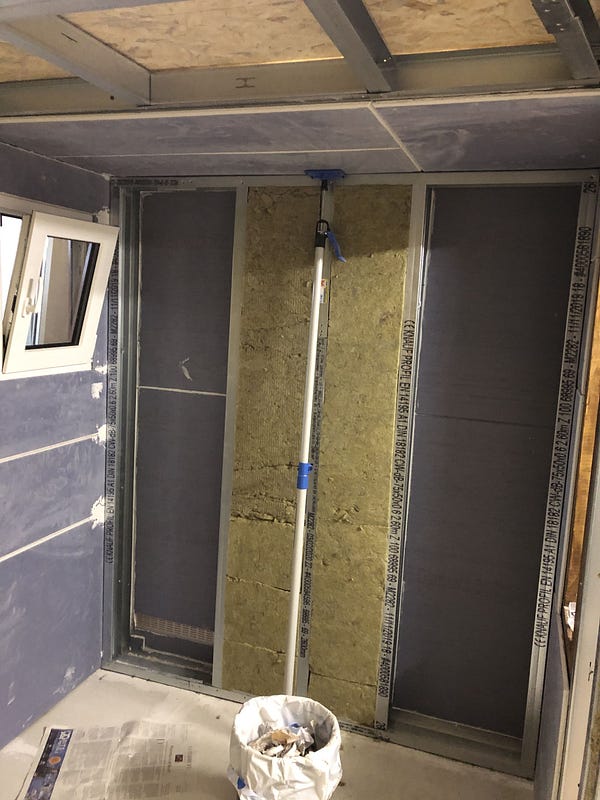
07/02/2020 Incidentally, this support is extremely helpful if you have to do the stuff yourself 🙂 
05/02/2020 The wooden boards are attached to the gypsum fiber boards with metal brackets and clamped in the profiles. I stapled the bubble foam. With the formwork from the inside, I have to wait for the next delivery of further gypsum fibreboards.


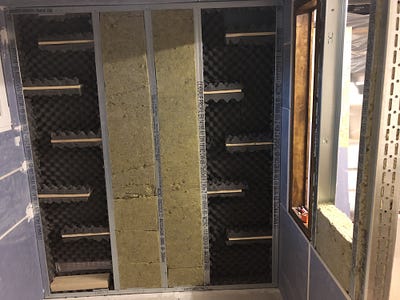
05/07/2020 The interior cladding is a bit fiddly: The cutouts for the ventilation grilles have to be milled and sawn, and the dimpled foam for the gaps between the boards cutted and stapled.



05/16/2020 Happiness is when everything fits. 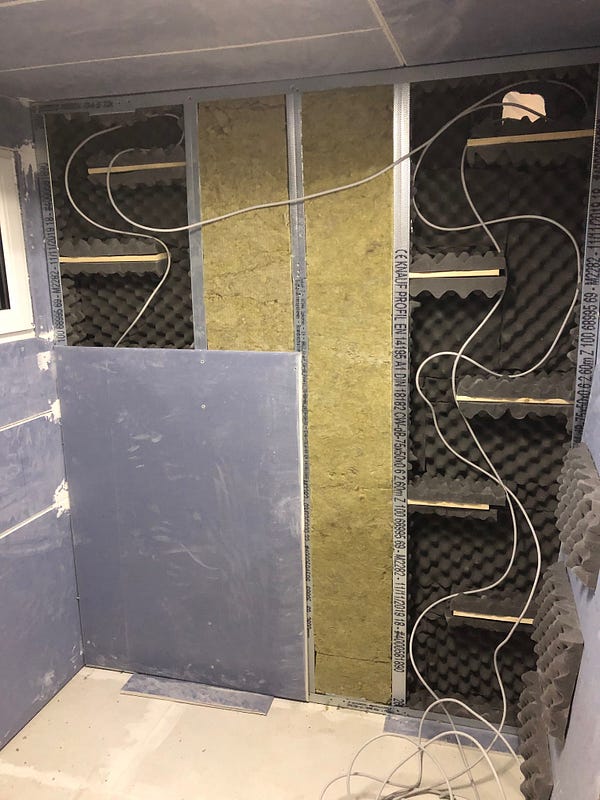
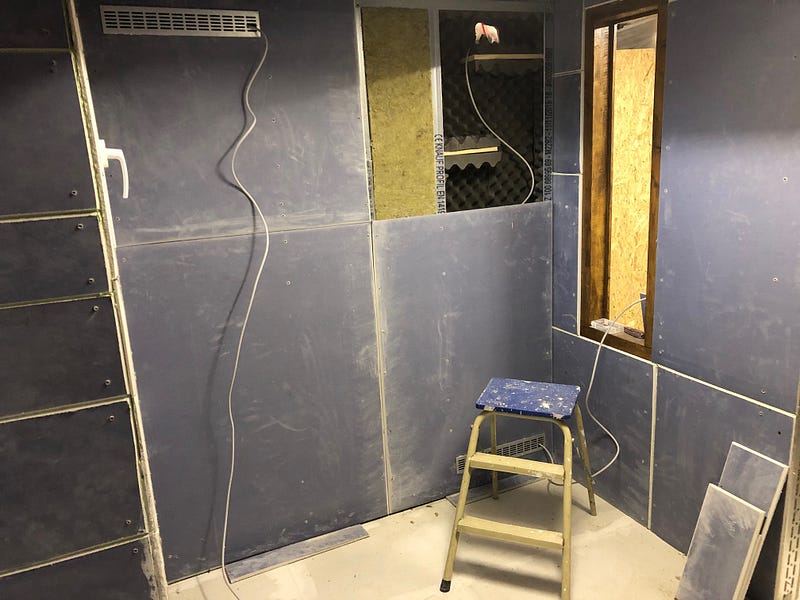
05/16/2020 I led power cables from the outside through the ventilation grilles. For this I broke sticks out of the ventilation grilles and put the cables in there over the labyrinth. Actually, drywall profiles made of metal allow cables to be laid quite easily directly in the wall. With my mix, however, a wooden beam gets in the way at the end of each wall. That’s why I decided to avoid major dislocations and to lay all cables inside the box using self-adhesive cable ducts. In addition, I do not have to drill any further holes in the panels that endanger the insulation properties.
For better maintenance options, I installed the fan on the outside of the cabin and donated a box with a labyrinth. If the fan is still too loud, I will expand the maze. Incidentally, the box is not permanently connected to the cabin. The top of the box is a board that is about 20 cm on the ceiling. The box hangs at the side of the soundproof cabin. The fan and the cabin are mounted on foam rubber so that no vibrations are transmitted to the cabin. From a previous project, I still had remains of fitness mats, which I also placed under the box (top and side). They make a wonderful contribution to decoupling!
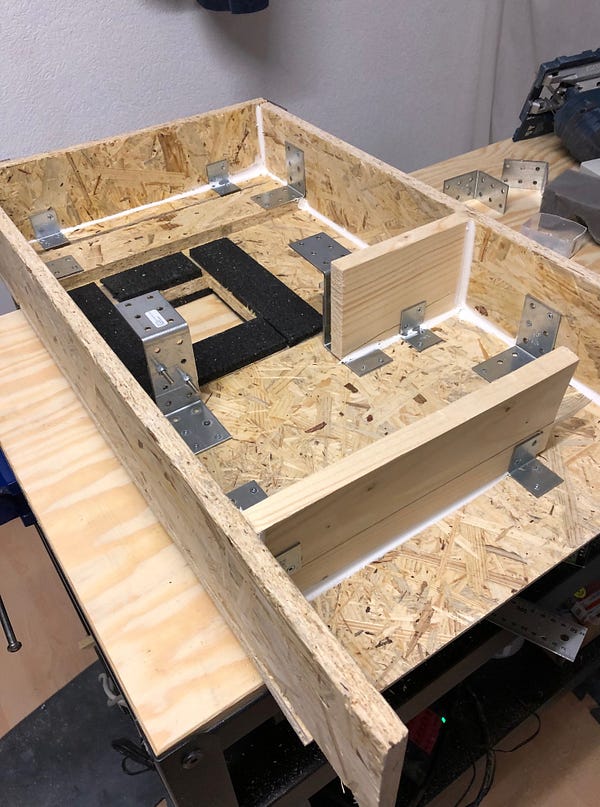

Sound insulation for the fan Last but not least, I gave the fan a speed controller. It remains to be seen whether I really use it in operation or whether I let the fan run mostly at full speed. Incidentally, the speed controller from ebmpapst REE10 was not that easy to get. I finally found him online in England. If you are interested, I can look again at which provider.

Speed controller ebmpapst REE10 The finished fan housing has gotten a cover. “Rustikal oak” subtly blends in with the rest of the vintage flair of my cabin 🙂. The somewhat strange looking recess at the lower end of the case was made because I didn’t have enough wood for a longer cover. I didn’t want to saw off the sides either. I wanted to stay flexible to extend the housing in case I need to further reduce noise emissions.

Fan housing in “rustic oak”
The Floor
In order to have it a bit more comfortable under my feet, I opted for a covering made of hard-wearing cork tiles. After laying / gluing a steam foil, I layered the tiles for 24 hours for acclimatization. The steam foil is probably superfluous in my case, but as a DIY newbie I just wanted to do it.
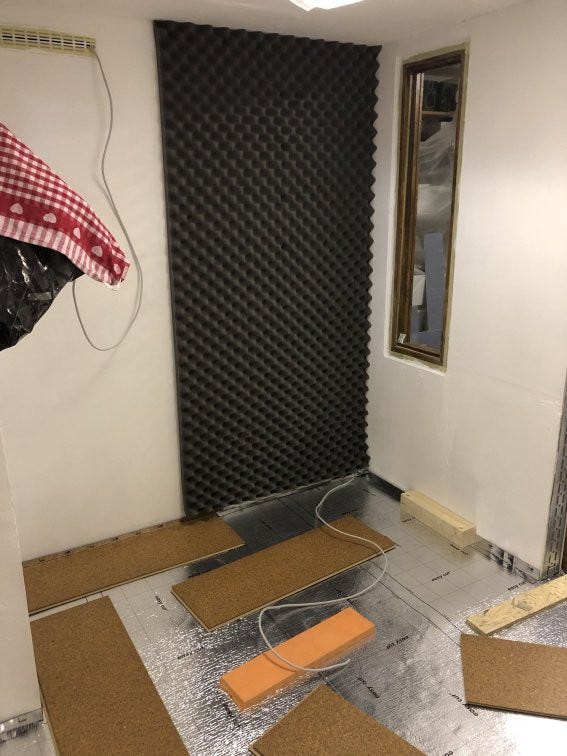
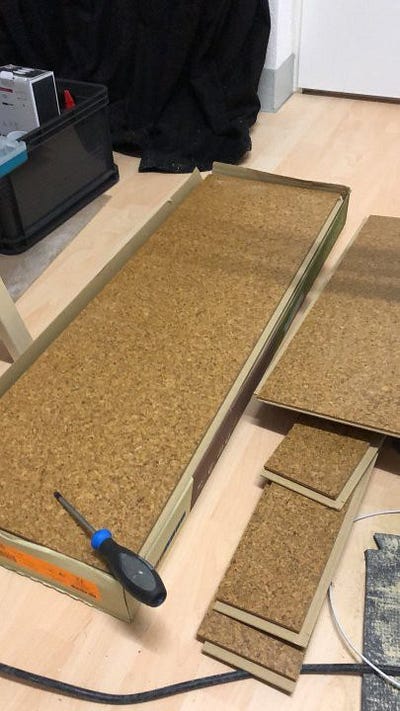

06/03/2020 Dampffolie und Probelegen der Korkfliesen Cutting to size with a fine wood saw blade is easy — after a few hours all the tiles were laid.
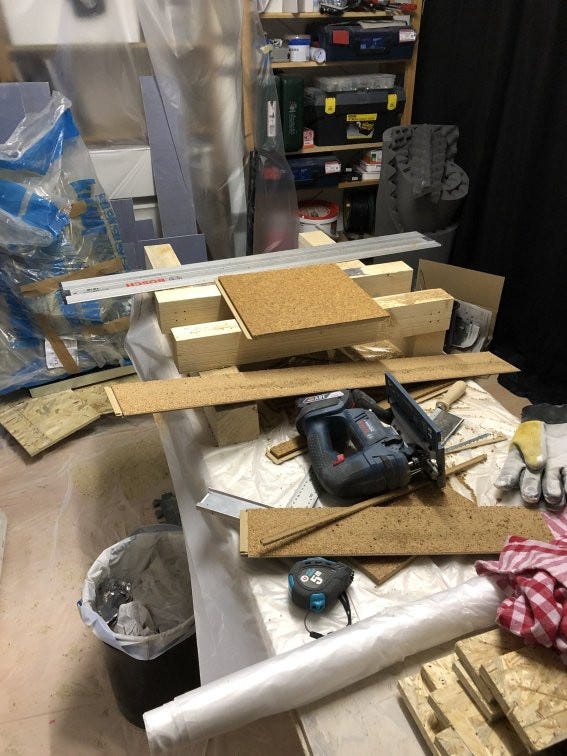
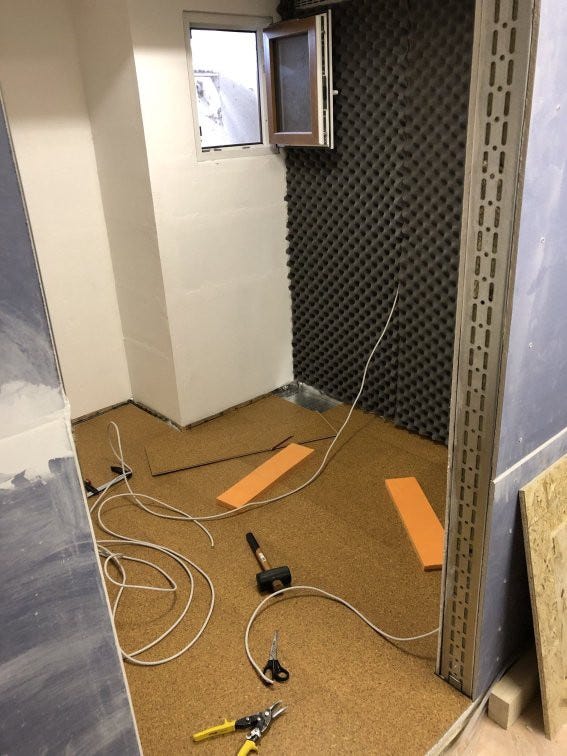
06/03/2020 Zuschneiden und Verlegen der Fiesen I used cork baseboards as finish off the wall. Since I didn’t want to drill any holes in the plasterboard, I attached the clips, that are usually used to hold the strips, with hot glue. That worked moderately well. In the end, I left out the majority of the clips and stuck the strips directly to the walls.

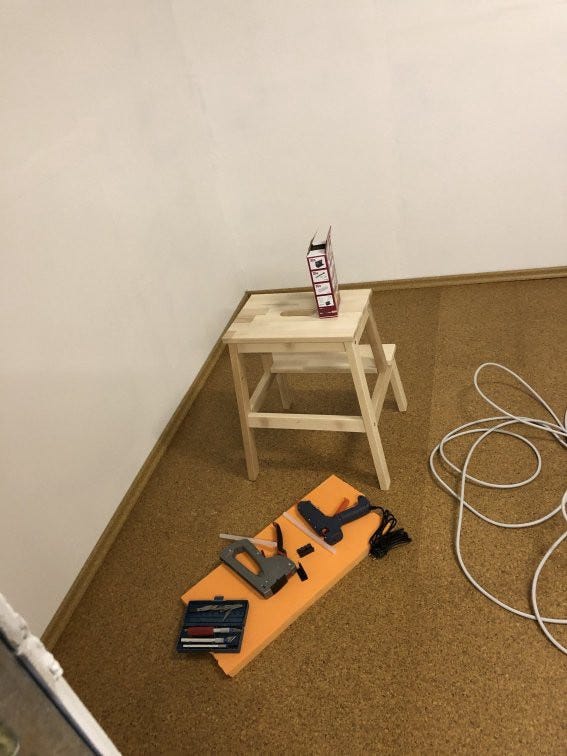
06/07/2020 Glueing baseboards 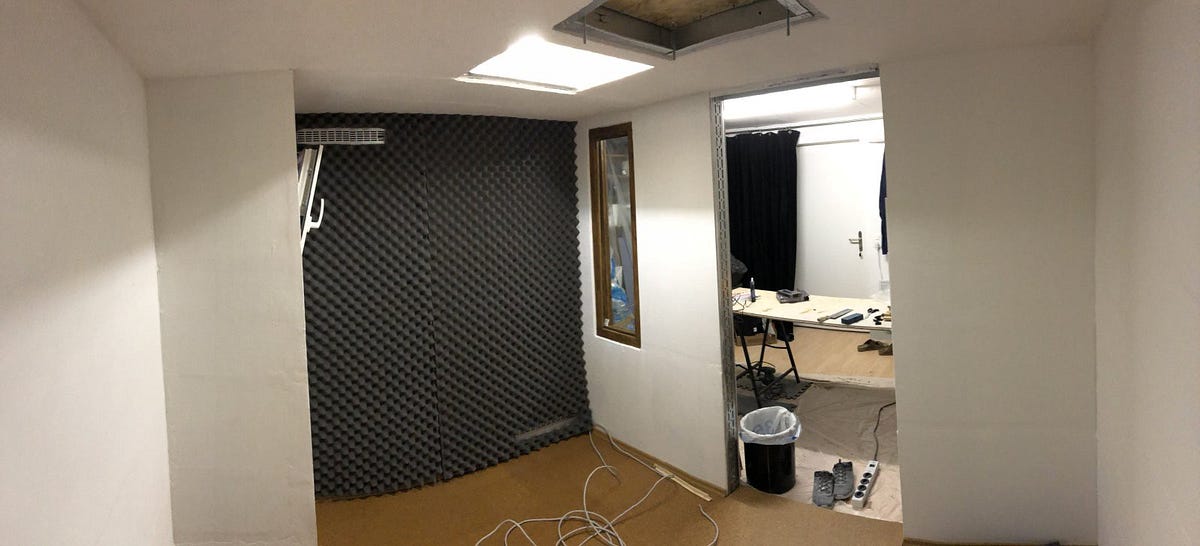
06/07/2020 The final floor
Window 2nd Edition …
Although I don’t need another window, but I created a small challenge in addition to the simple routine of construction, to satisfy my need for luxury. It should be self-made with optimized acoustic properties. Specifically: double glazing with an 8mm and a 12mm slanted pane.
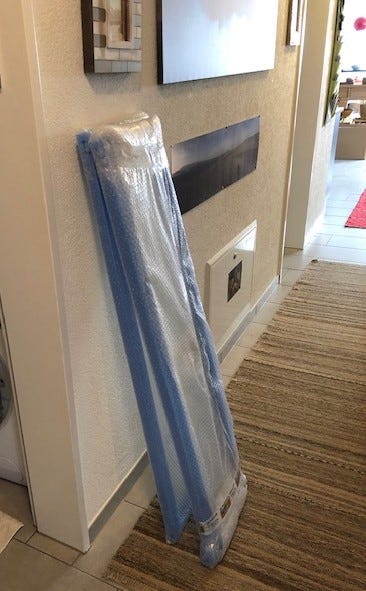
Glass panes (12mm and 8mm) for the window construction The frame construction consists of screwed 80x80mm square timber, which is supported by a UA profile in the metal frame.


Align the window frame I sawed the frame and bars angled to hold the panes in place and then painted them with wood varnish (luxury as I said).
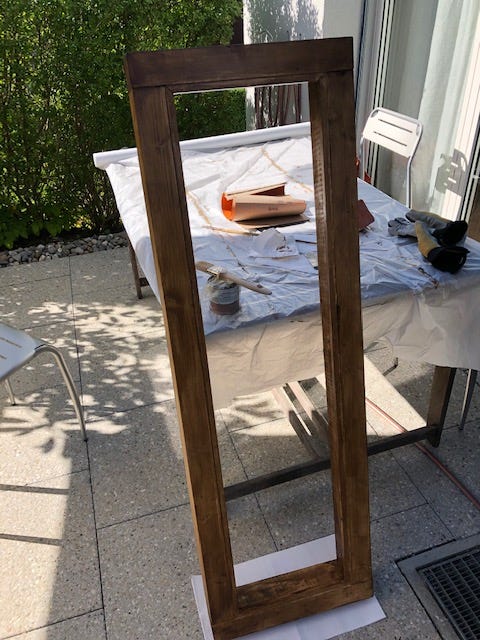

Prettyness with “Oak Rustic” The wooden frame is screwed to the CW profiles and sealed with 2K cunstruction foam. On the occasion I also sealed the small window in the back.
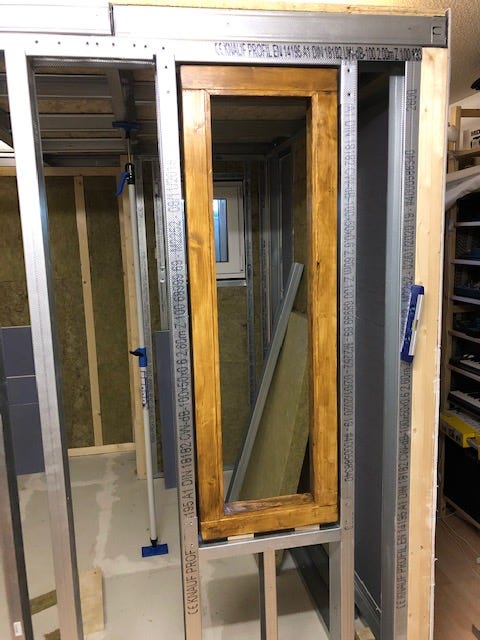
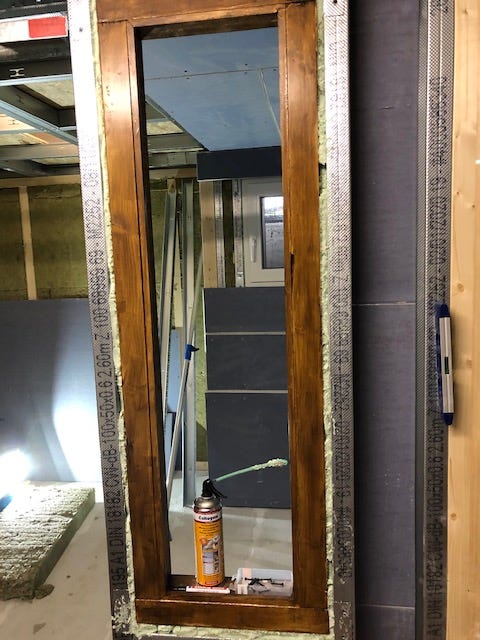
The first thinner 8mm pane is inserted and fixed with the profile strips. Of course, I had to pre-drill the screw holes in the thin wood. Incidentally, you cannot see the window seals (self-adhesive rubber P-profiles) that I glued to the wooden strips. Then brown acrylic helps so that no beeps really get through. Dark or brown acrylic, because a white seal would be reflected from the inside of the panes (I never thought about anything like this before this project (in my previous life) :-))).
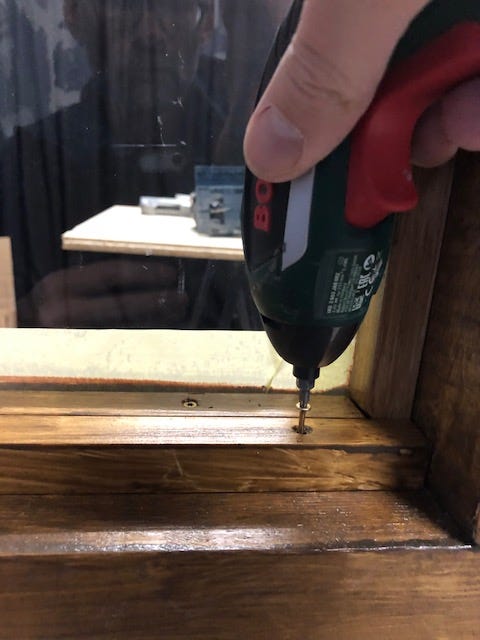

At the bottom it’s 15mm from the frame to the window and at the top just under 40mm. On a length of 1200mm there is a difference of 25mm. If Pythagoras wasn’t completely wrong, the angle is slightly less than 2 °.
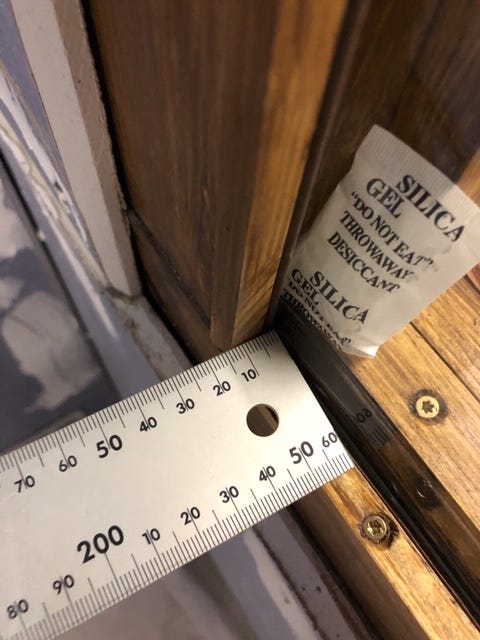

You can clearly see how the light breaks differently in the window (everything is reflected twice) — and so does the sound. With this construction, less resonance (aka standing waves) should be formed and flutter echoes should be avoided. We’ll see…
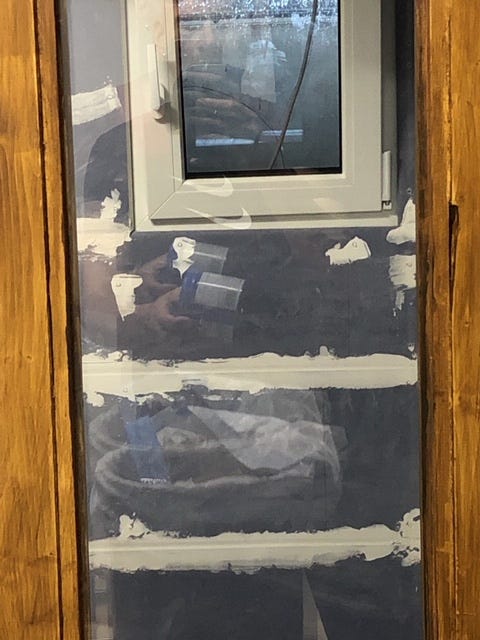
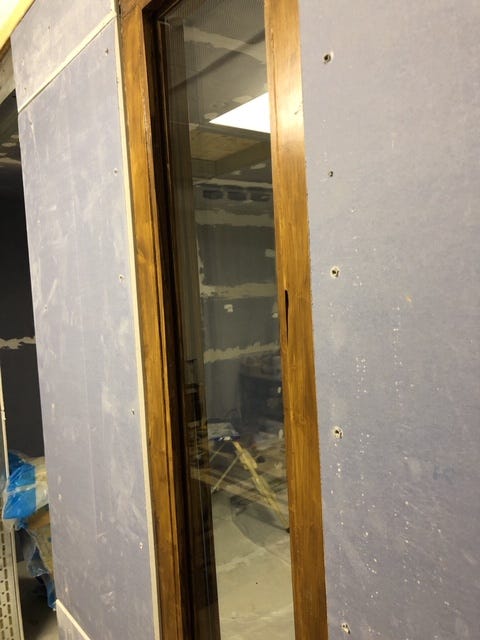
The Door
Doors, the weakest elements in terms of sound insulation, require special attention. 80 kg heavy and equipped with a retractable smoke protection, I had respect for the installation — nothing should go “wrong” in the truest sense. I ordered the door (soundproof door set white RAL 9010 CPL with surrounding frame — Interio, 37 db Rw, P — soundproofing class 2) in a set with the frame from www.deinetuer.ch. A damping level of 37 db Rw seemed to be sufficient for my purpose. More would have been possible, but then the door would have become more expensive and heavier.
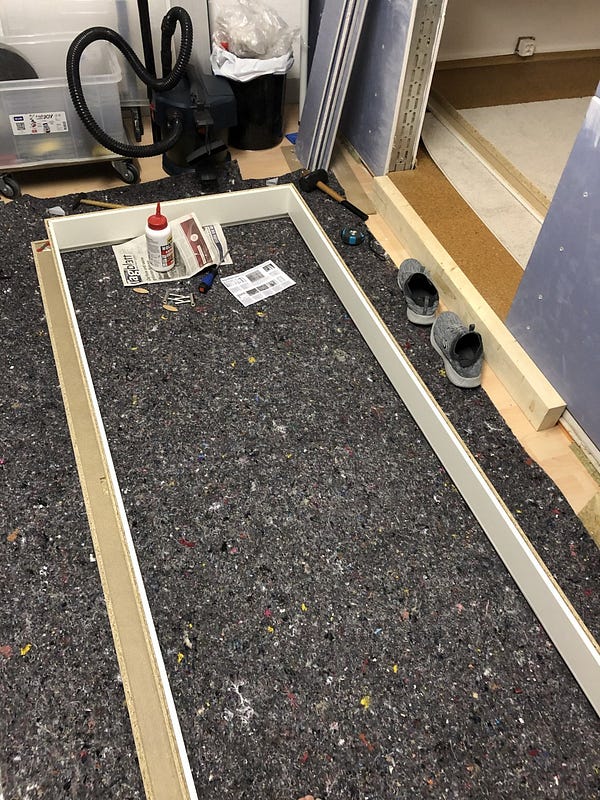
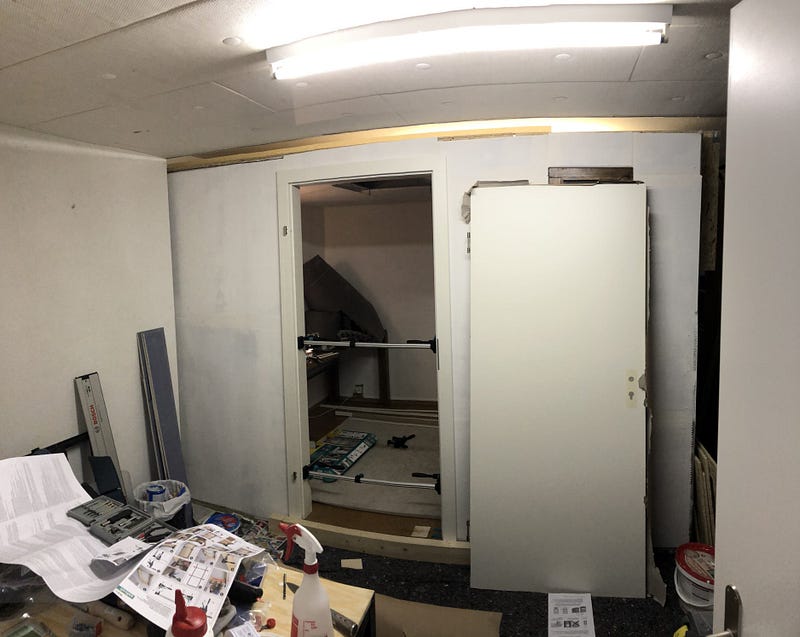
8/20/2020 Assembly and alignment of the frame But how do you fix a door frame that has to carry a bit more weight than usual into a free-standing drywall made of metal profiles? The reference in the assembly instructions to wall anchors is daunting. Since beauty is secondary, extra strong self-tapping screws are needed, which are drilled through the frame backed with wooden panels and screwed into the metal profiles. Afterwards, everything stays in place with foam.

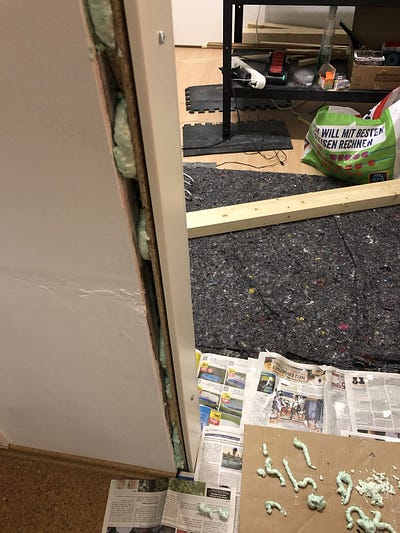

08/24/2020 Metal drilling screws to fix the frame During assembly, I noticed that the door is sitting in the frame but protruding slightly. Seen from the side, she is sitting on the cabin wall. The door “floats” above the exterior floor. The retractable smoke protection hangs ineffectively in the air.

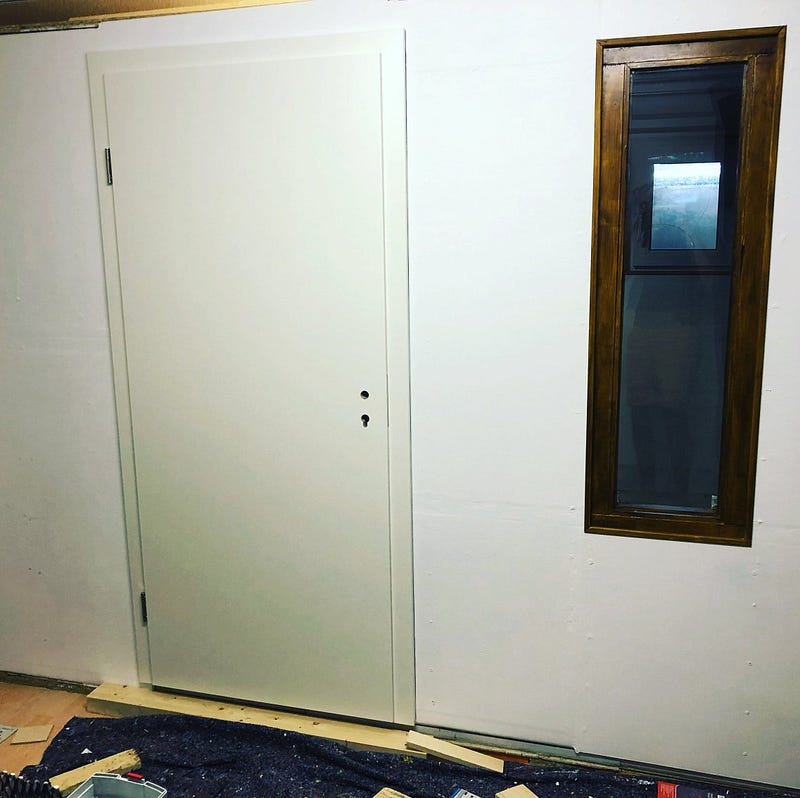
A (not planned) door threshold, which I extended across the entire width of the cabin for the sake of appearance, offers enough resistance for smoke protection and seals well. Remnants of the cork tiles, as well as aluminum profiles for stair nosings, also make the construction reasonably pretty. The threshold consists of two screwed 80×80 square timbers that only lie on the floor. A screwed metal plate connects the threshold to the cabin floor. Nothing wobbles there!

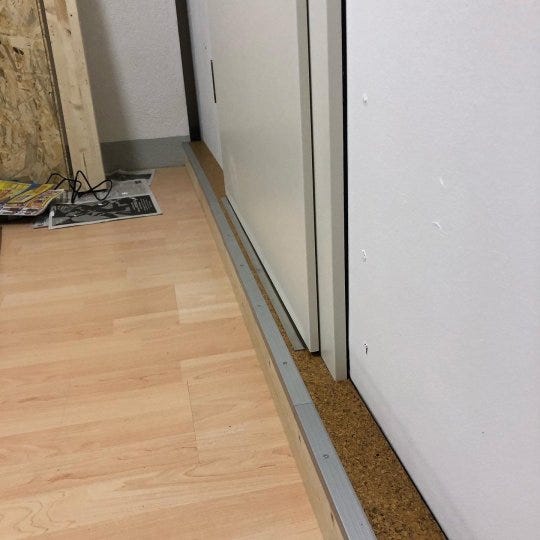
08/28/2020 Door threshold to seal the door to the floor When closing, you notice a slight counter pressure — the room air is slightly compressed, which indicates good air and therefore sound insulation of the cabin, great! I filled the keyhole with plaster of paris and covered it with a piece of white cardboard (first seen in the pictures below).

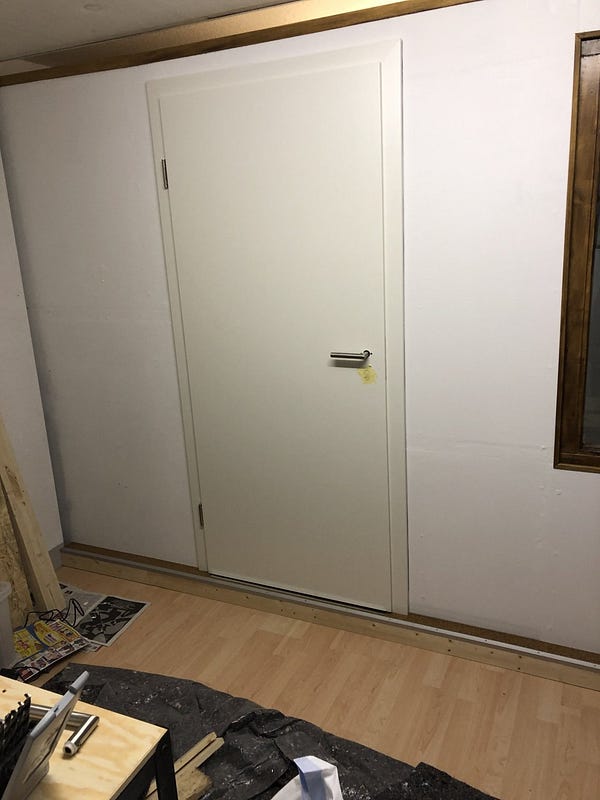
08/28/2020 The fully installed door with handle
Finally …
… some impressions of the completed cabine from outside …
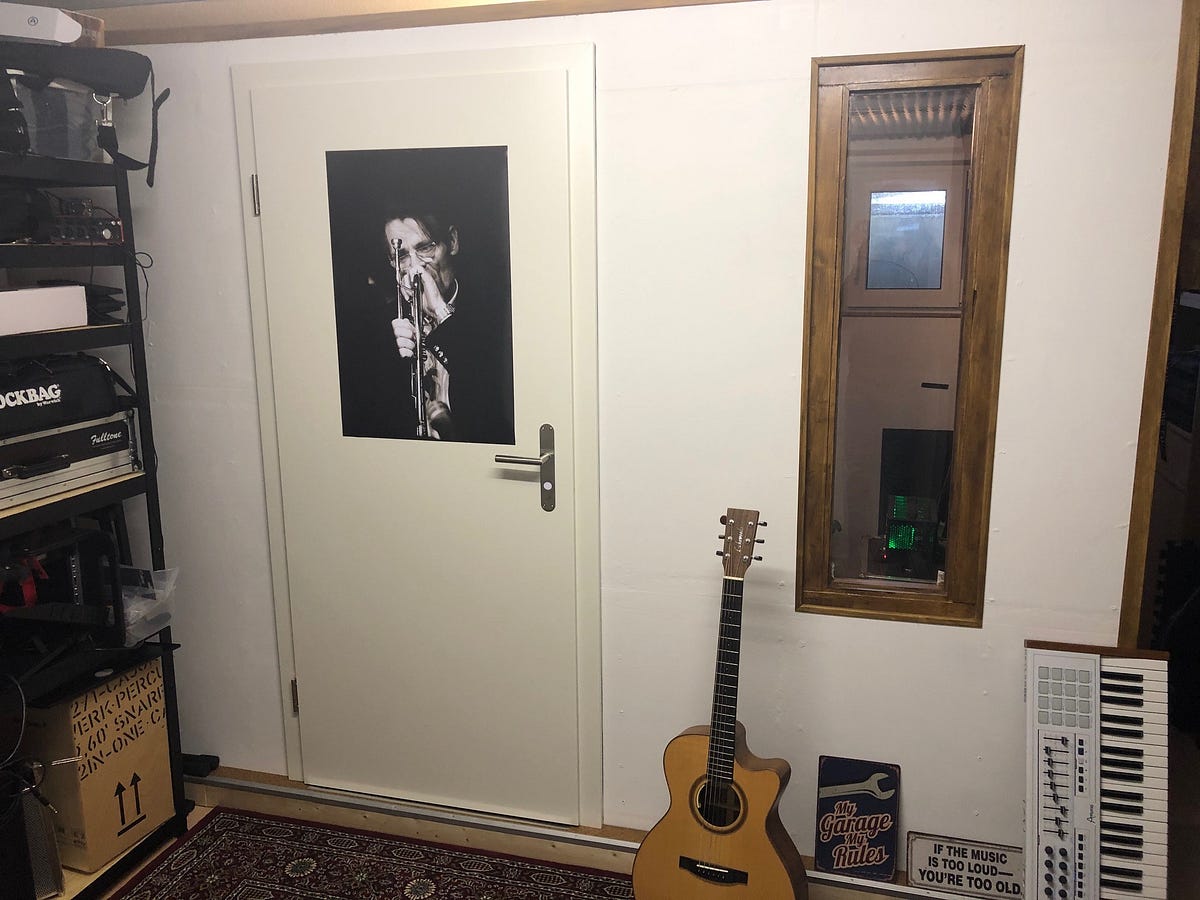
Done! 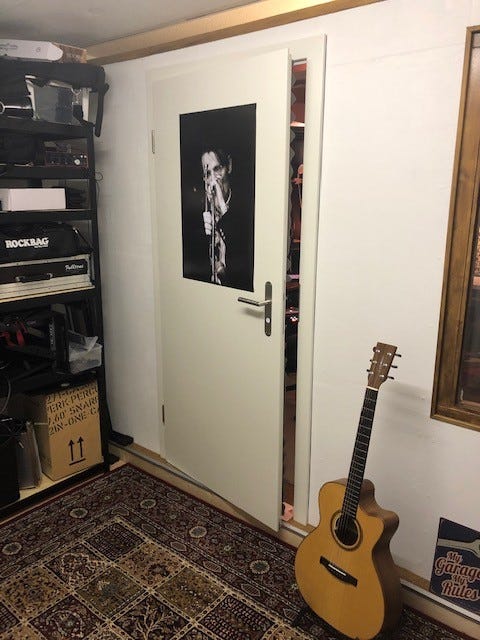
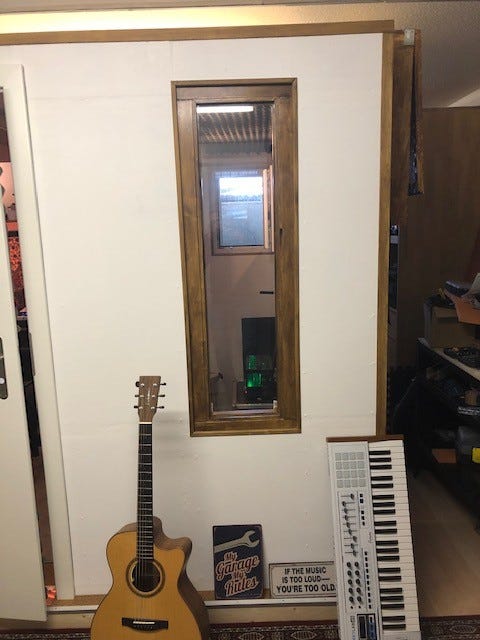
The door and front window. 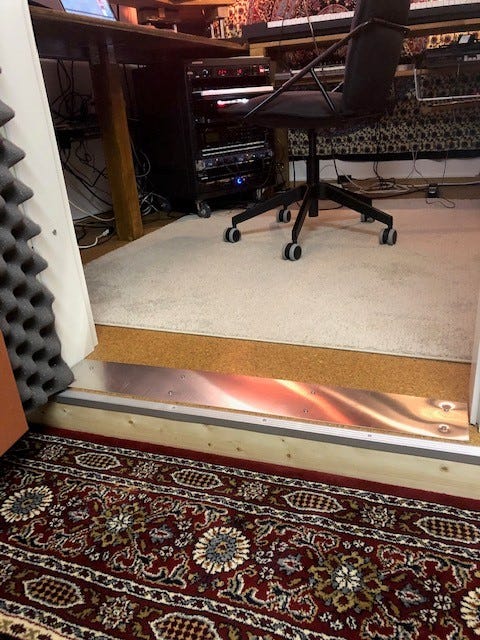
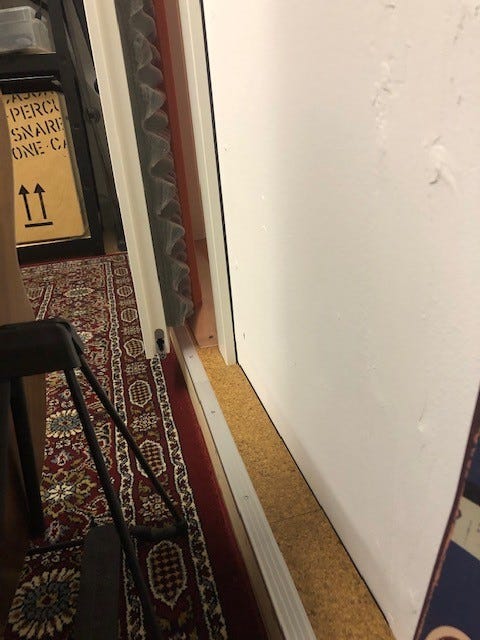
Doorstep & lowerable sound and smoke protection. 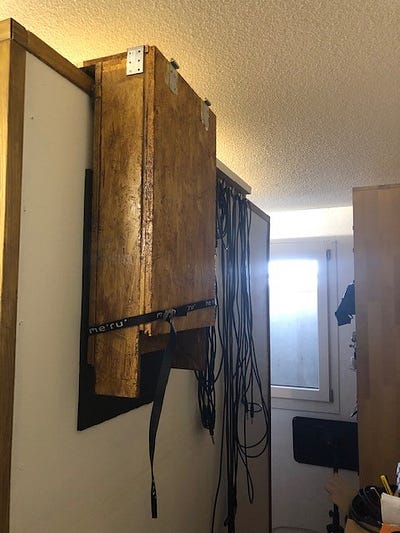
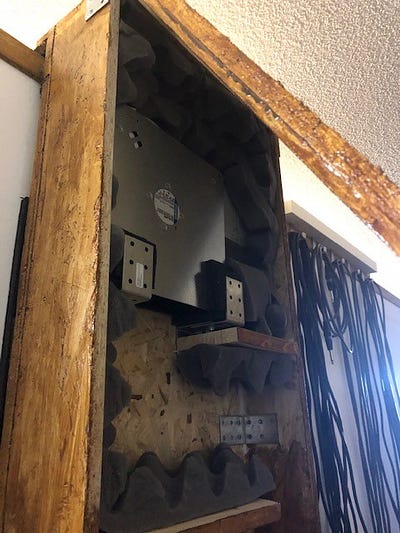
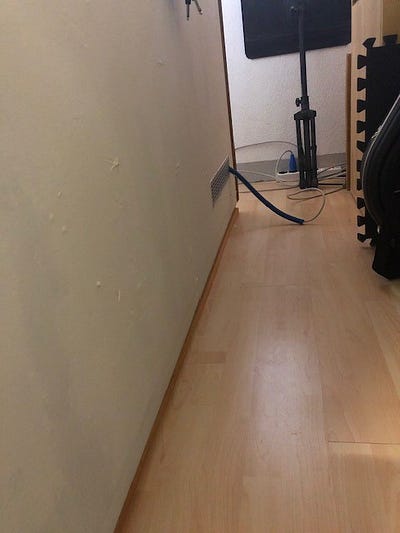
The box for the fan and air outlet also used for the power supply. 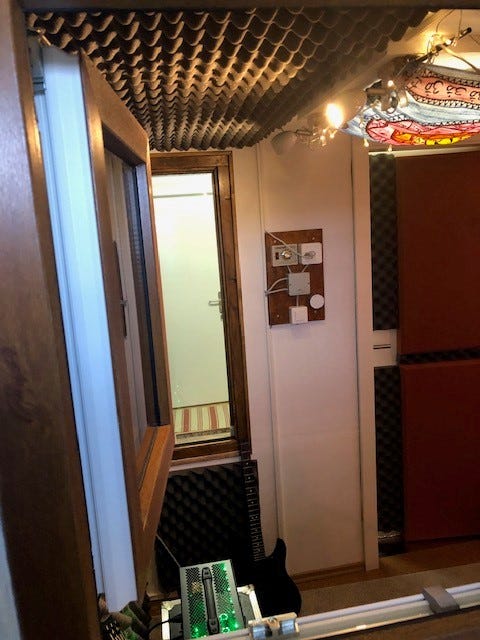
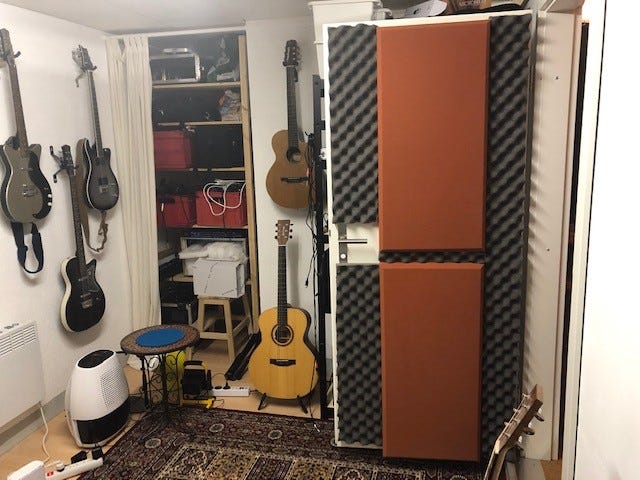
View from rear window through the cabine and the area in front. … and inside.
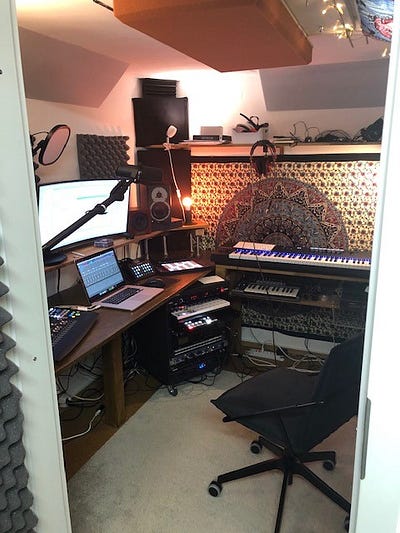
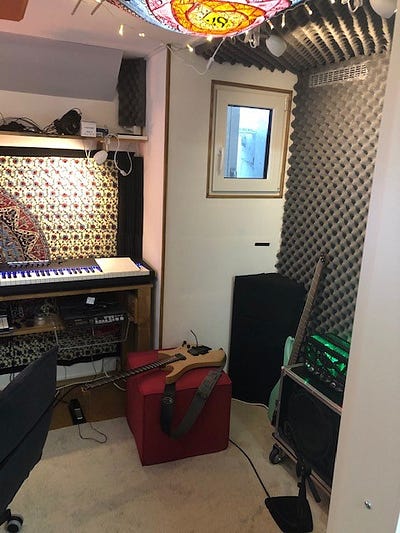

View inside and on the right side some analog gear. 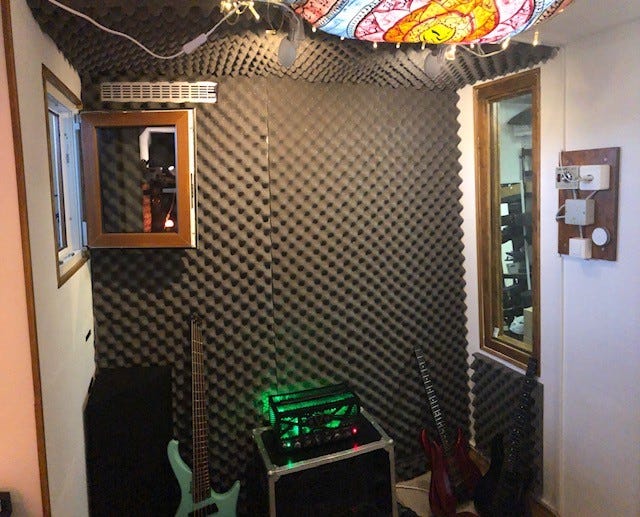
On the right side the main power switch and the speed controller for the fan. In case you want to know how to construct simple basstraps (as shown above and below in black in the corners), I recommend this article to you:
https://mark-evertz.medium.com/diy-basstraps-5e96bb24a8c3
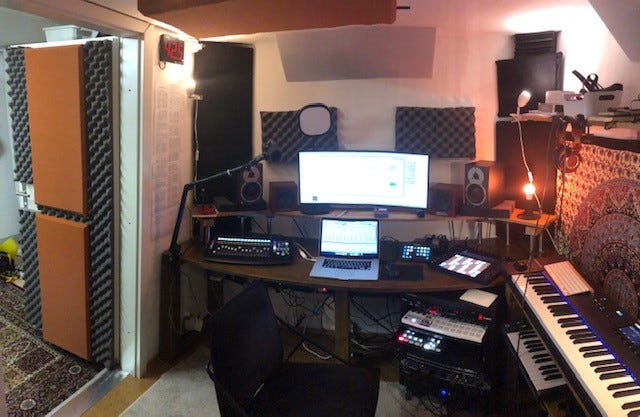

Fun sector with some more devices. 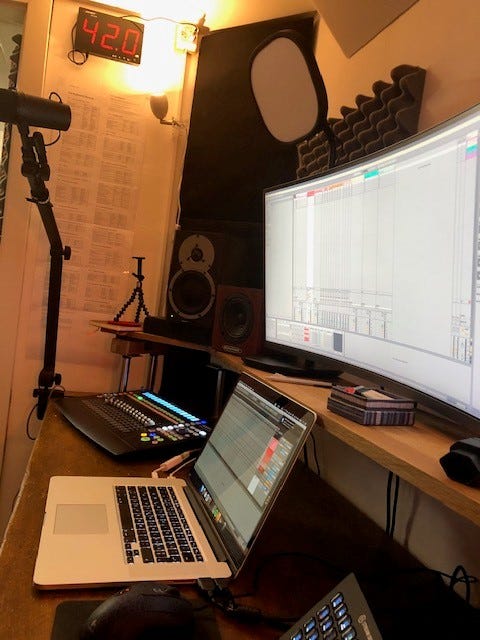
DB measuring device and a list of short cuts for the DAW (Ableton Live). 
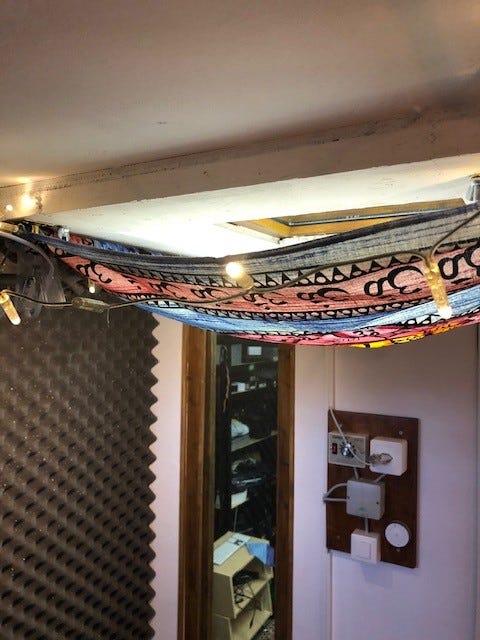
View through the soundproof window from inside and to the right the window in the ceiling that has been converted into an inspection flap.